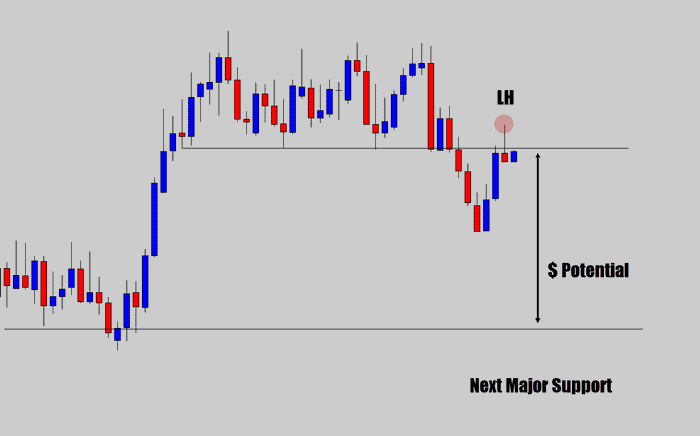
Are you sick of suffering from crippling anxiety when you’re looking at your charts price movement for something to trade?
Do you want to be able to read a price chart fluently, and see the price action based trading opportunities without the headaches of ‘analysis paralysis’?
That’s the name of the game with a price action strategy – keeping things logical, simple, and minimalistic.
This tutorial will cover how to ‘extract’ price action trading opportunities from a ‘naked chart’, without needing to pollute it with confusing crap.
To start things off, I have a trade demonstration video to show you.
In this video, I walk you through two live price action strategy based trades I documented from start to finish – and this will be a good ‘primer’ for the rest of this lesson and how I like to trade from day to day.
Video highlights:
- The overall price action strategy I can show you how to trade
- The kind of content covered in this course
- The actionable information you can take away to apply to your trading immediately
Are you pumped now? Here is what is coming up…
- What Makes Up Price Action Analysis? The Start to a Profitable Journey
- The Candlestick Patterns You Need To Know First
- Ranging Markets Made Really Simple
- The Price Action Secret to Identifying Trends and How To Trade Them
- More Price Action Patterns For The Resourceful Trader
- Price Action Trading Setups
- Exotic Charts Nobody Talks About
- Tools For Price action Traders
- Price Action Trading Course
What Makes Up Price Action? The Start to a Profitable Journey

Price Action; the most popular trading style for us retail traders, and very widely used by professional institutional traders – but what is it truly?
Is it just trading candlestick signals off support and resistance?
This is what most people’s perception of price action is:
“The study of price action trading is simply watching and waiting for your favorite candlestick pattern to pop up, and nailing the buy and sell button when it does, before you miss out!”
The internet is polluted with too much misinformation, and that’s how these damaging beliefs are conceptualized.
The purpose of this guide is to fill the knowledge gaps, and set you up with the right mindset going forward!
If someone asked me what ‘is’ the price action methodology and how you trade it – I would break it down to these 4 core components:
- Chart analysis – Combining market structure analysis with other technical features (including top down analysis)
- Trade signals – A variety of candlestick patterns and breakout events (more specific ones than others)
- What I call a ‘position check’ – A context check. Are we in the right position, or out of position? (trading signals from areas of no technical value)
- Ability to forecast – Can you make an accurate forecast based off the information you have on the chart?
These are my 4 key steps on making a trade decision.
Before you consider taking any action on a trade, chart analysis needs to be done. You don’t do anything until you can get a read on the chart first!
Price action is all about taking information from the “naked” charts, and forecasting price movement without having load up your template with unnecessary indicators. But, before we get into that, lets actually talk more about the charts first.
Below is an example chart (which I found on forex factory). These kind of ‘data heavy’ systems are quite common on public forums….
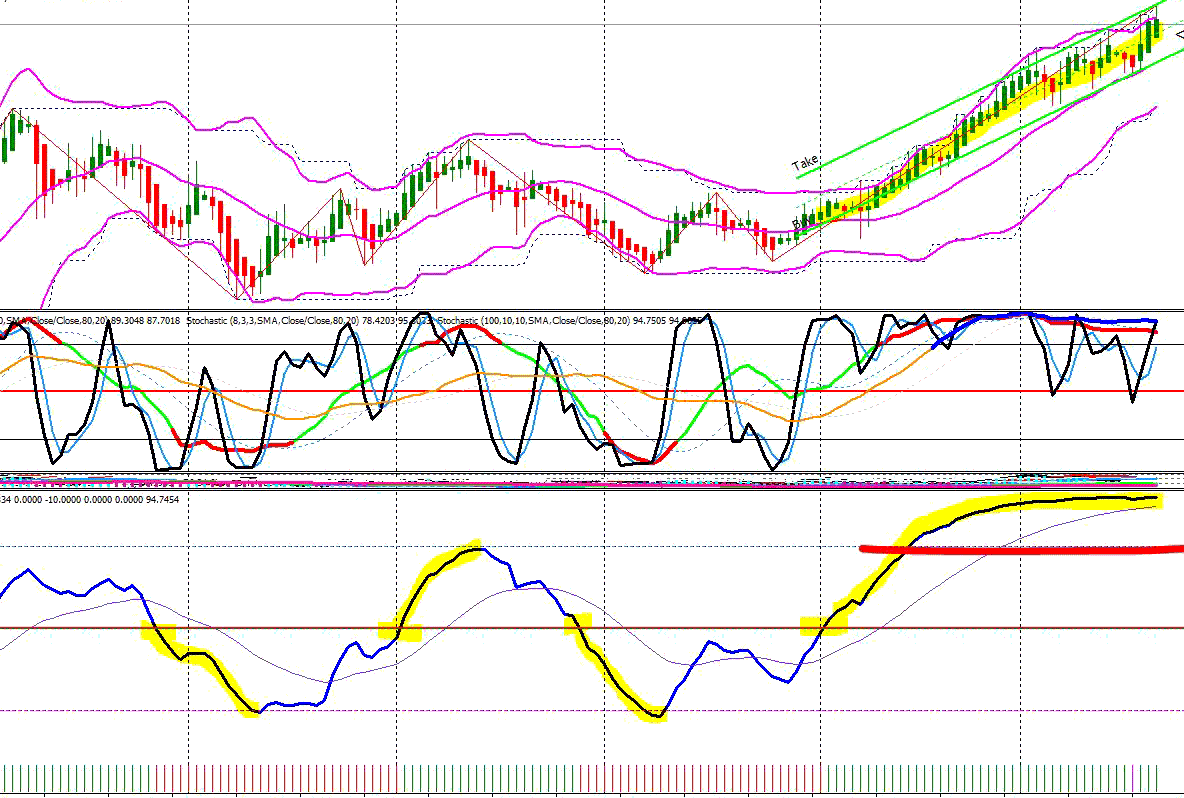
The above chart looks potentially exciting to play with short term, but there’s too much information which would make it frustrating to use long term. In my opinion, this kind of work space demands a lot of data processing from a trader, day after day – which I know can get very tedious quickly.
I would much prefer to work in a cleaner, simpler, price action based environment like this:
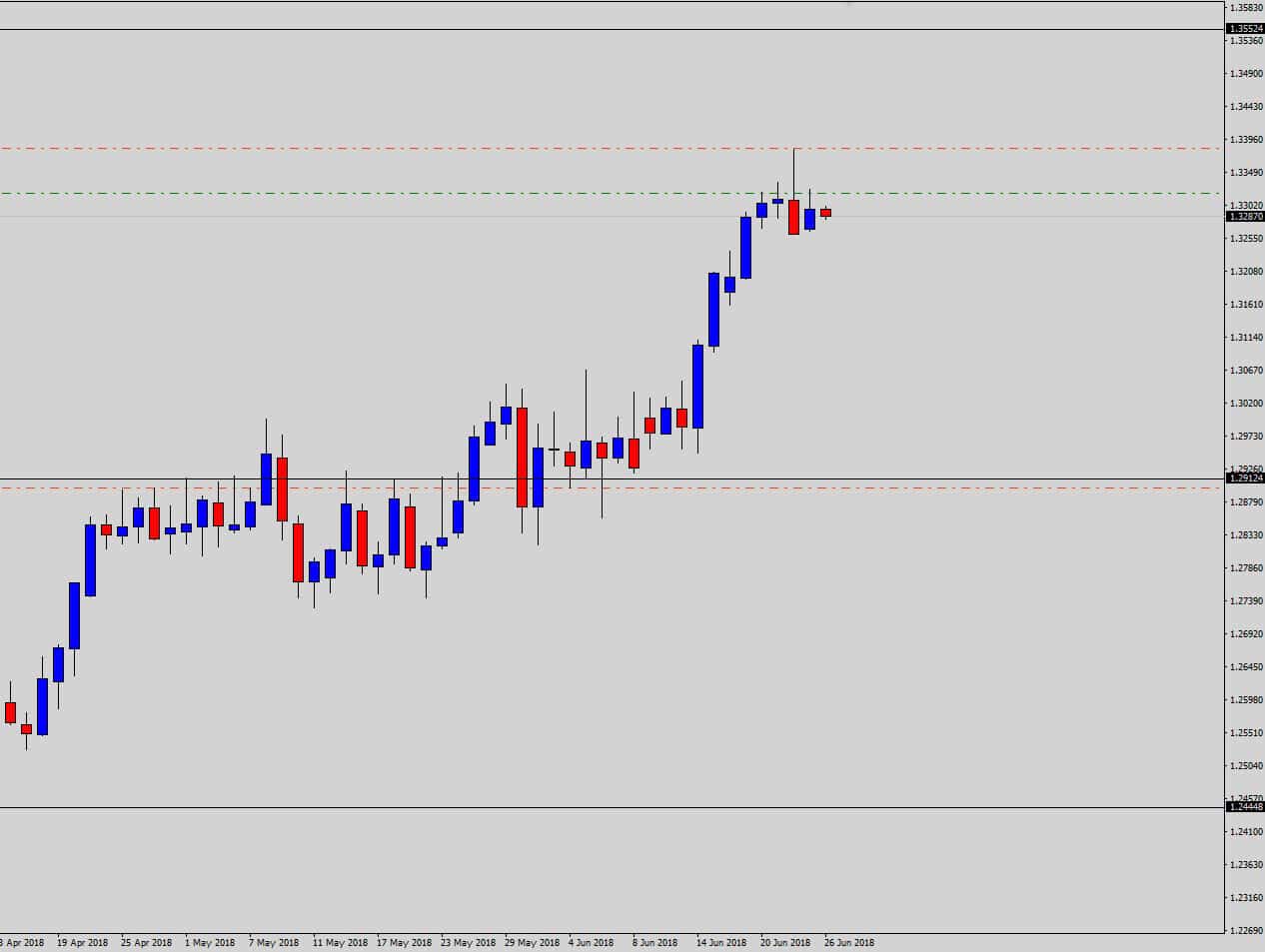
Above is my chart. It’s a clean, simple to process, price action trading environment. I am trading bearish rejection on the USDCAD and looking for a mean reversion to play out.
That’s why I love Forex price action based systems:
- No fancy tools needed, just work directly from the charts
- You simply “trade what you see, not what you think”
- It is easy to come up with logical trade ideas
- No need to process a tsunami of data to make a trade decision
- Keeps things simple, logical, and easy to work with
When your eyes first land on that chart – establish the type of market conditions you’re dealing with; is it a tradeable environment to begin with, or not? Don’t put money down into charts you can’t read and understand.
Draw from your basic technical analysis skills – which a lot of novice traders let themselves down by completely skipping over this step!
Stick around through the tutorial, we will be looking at all the different aspects of my trading strategies, and how you can take all this back to your charts right now, and start trading with it…
Checkpoint
The Candlestick Patterns You Need To Know First To Forecast Price Movement

The most well-known aspect of price action, is the candlestick patterns.
Candlestick charts were introduced to us first by Steve Nison in his original book “Japanese Candlestick Charting Techniques.”
Other pioneers like Martin Pring, who wrote a book called “Technical Analysis Explained” introduced the pin bar to the charting world, which is still a very hot topic for price action traders to this very day.
Let me show you some candlestick patterns, and the concepts behind them that will help you get started with a price action trading system.
Moving forward I need you to be able to read a basic candlestick chart. If you need more knowledge on reading candlesticks – check out my guide on reading Japanese candlestick charts before moving on.
Long wicked candles to Predict Upcoming Movement
When a candlestick has a large upper or lower wick coming out one end of its body, it represents a rejection response from the market.
This rejection can be an early warning indicator to a pending reversal.
Long wicked candles are the templates for candles like: the pin bar, hammer, shooting star, and my favorite the rejection candle (which is what I mostly trade).
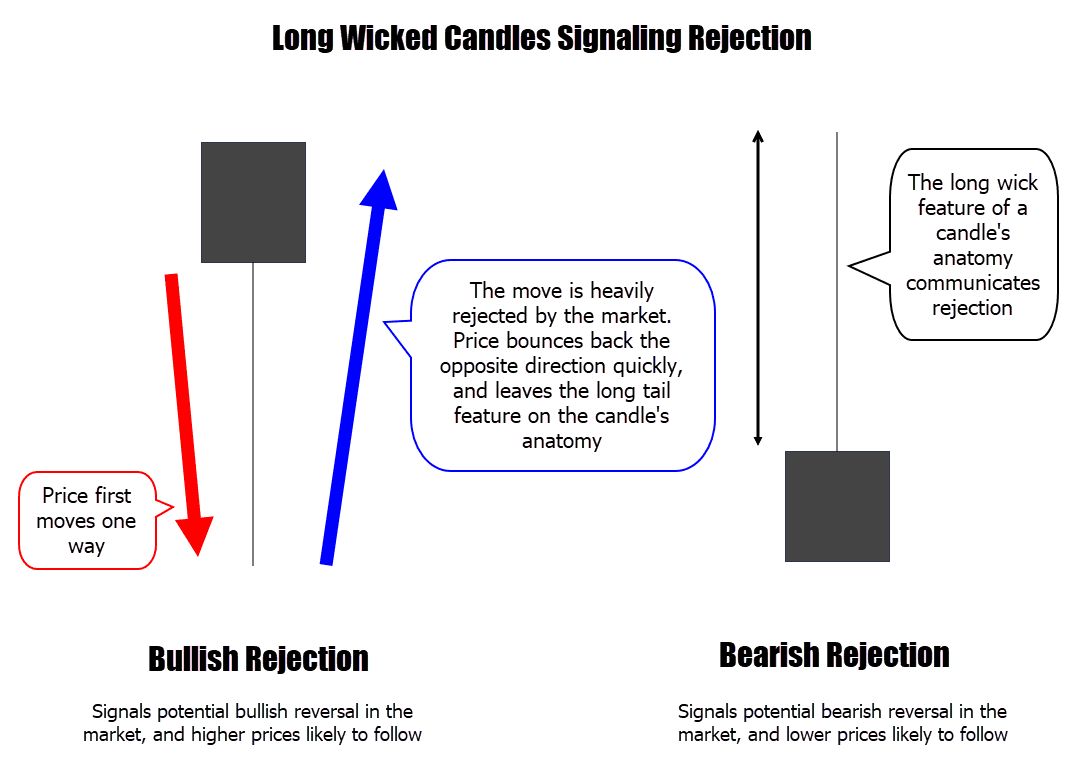
The long wick on a candle’s anatomy suggests the market is likely to turn around into higher or lower prices, depending on which way the rejection is coming from.
In short, it is a price action reversal signal, because it is possible to make forecasts of future price movement based off this rejection.
That is why reversal/rejection type signals are very popular – traders buy or sell the markets when they spot long tailed candles reacting with their technical “areas of interest”.
Lets have a look at some examples…
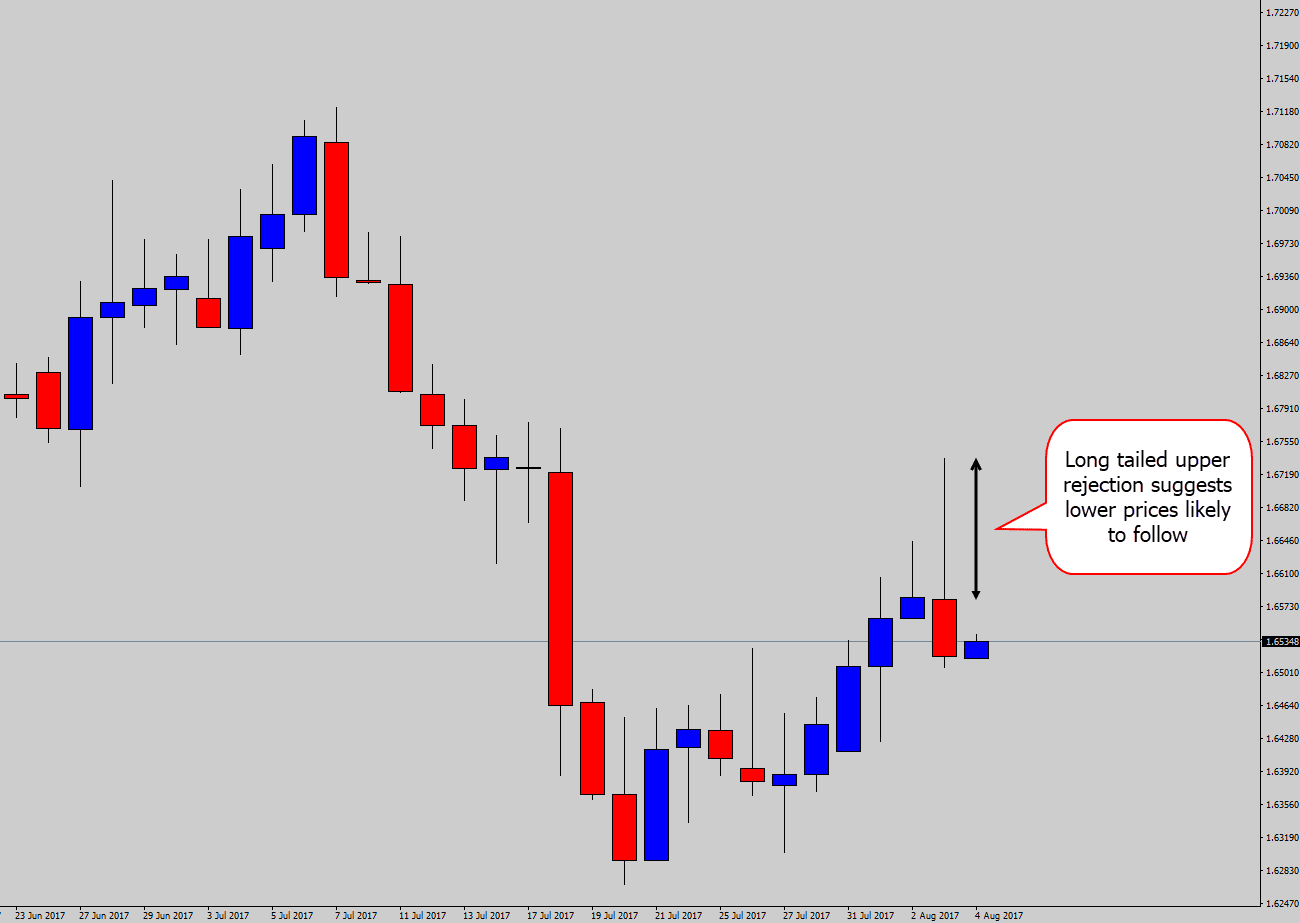
The long tailed candle above is signalling the market is likely to follow through with the bearish rejection and move lower.
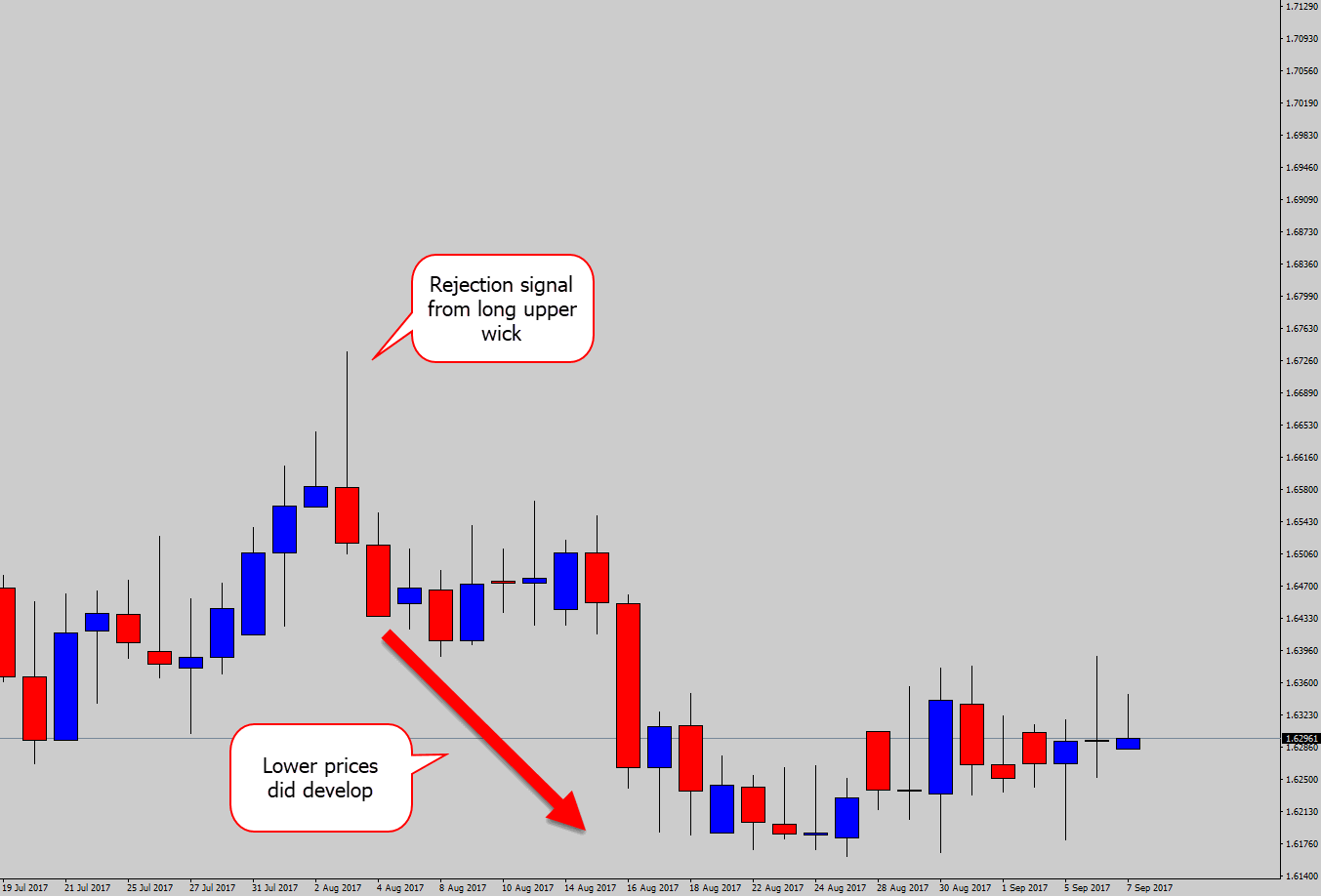
We can see that it certainly did follow through to the downside, producing a profitable trade.
Lets check out a bullish example…
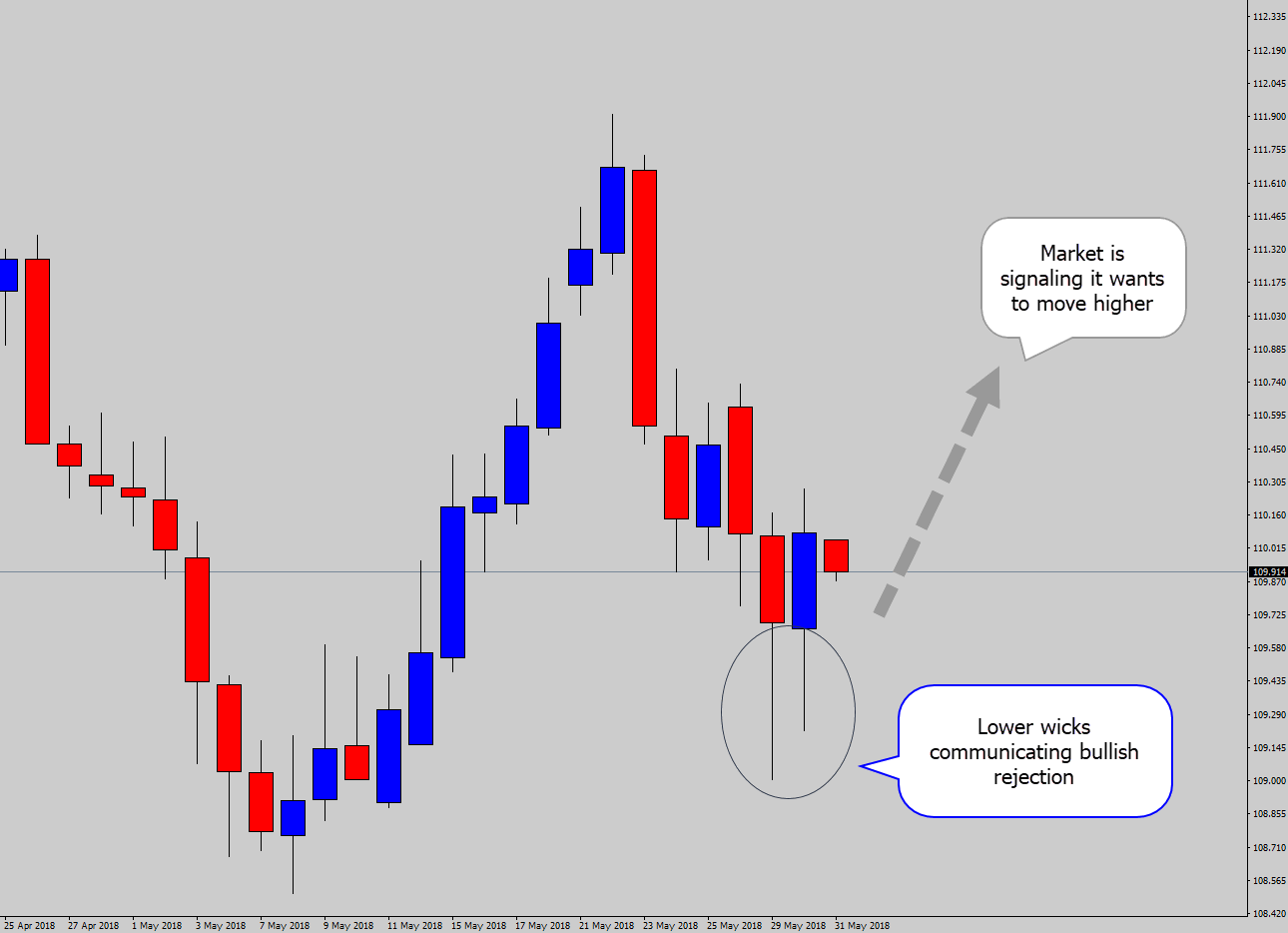
Where do you think the market is likely to move after two candles consecutively print large lower rejection wicks?
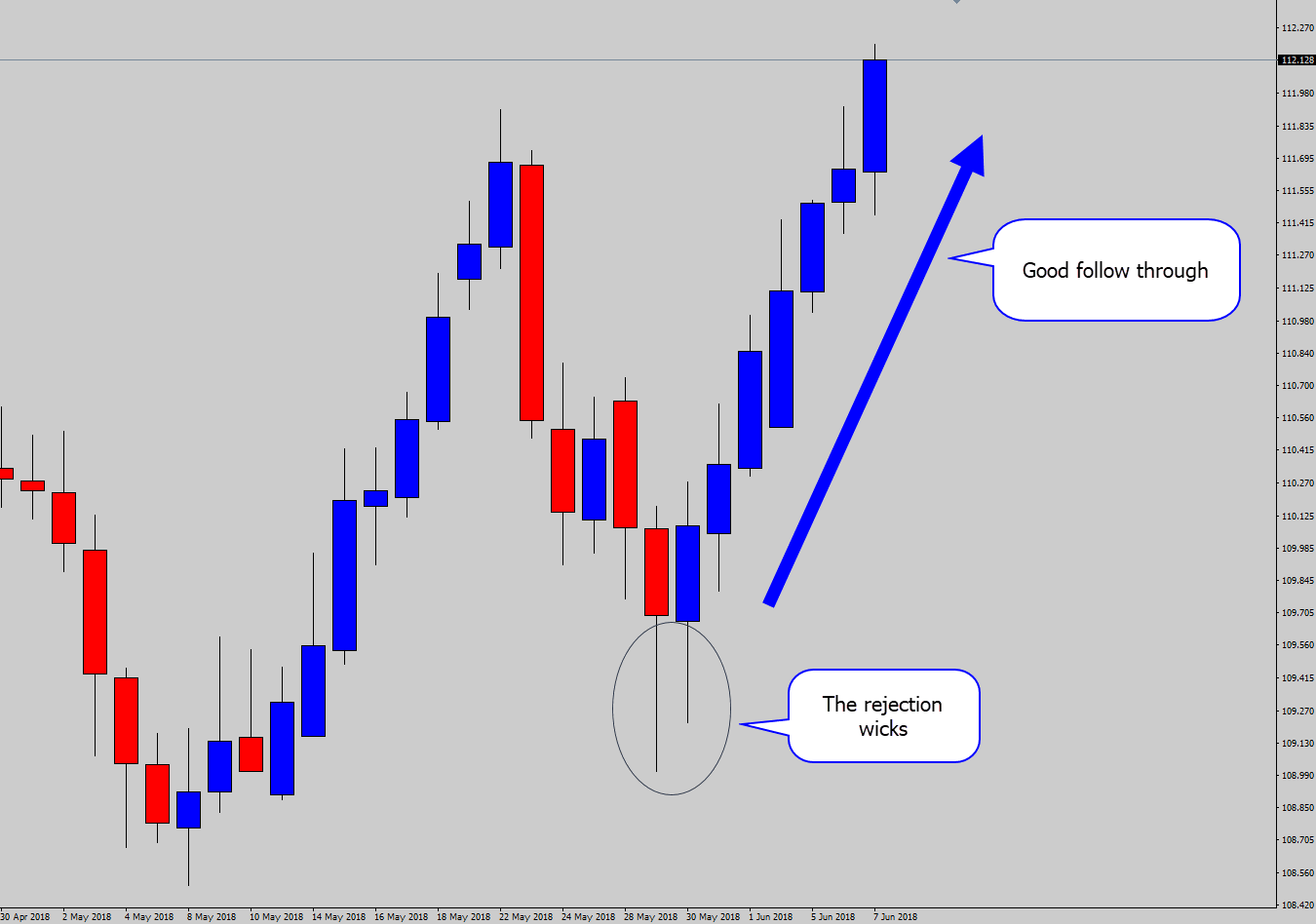
Yes, this one did produce a nice bullish move that followed through with the lower wicks.
But can you just blindly trade off every large rejection wick you see? Here is a really obvious one…
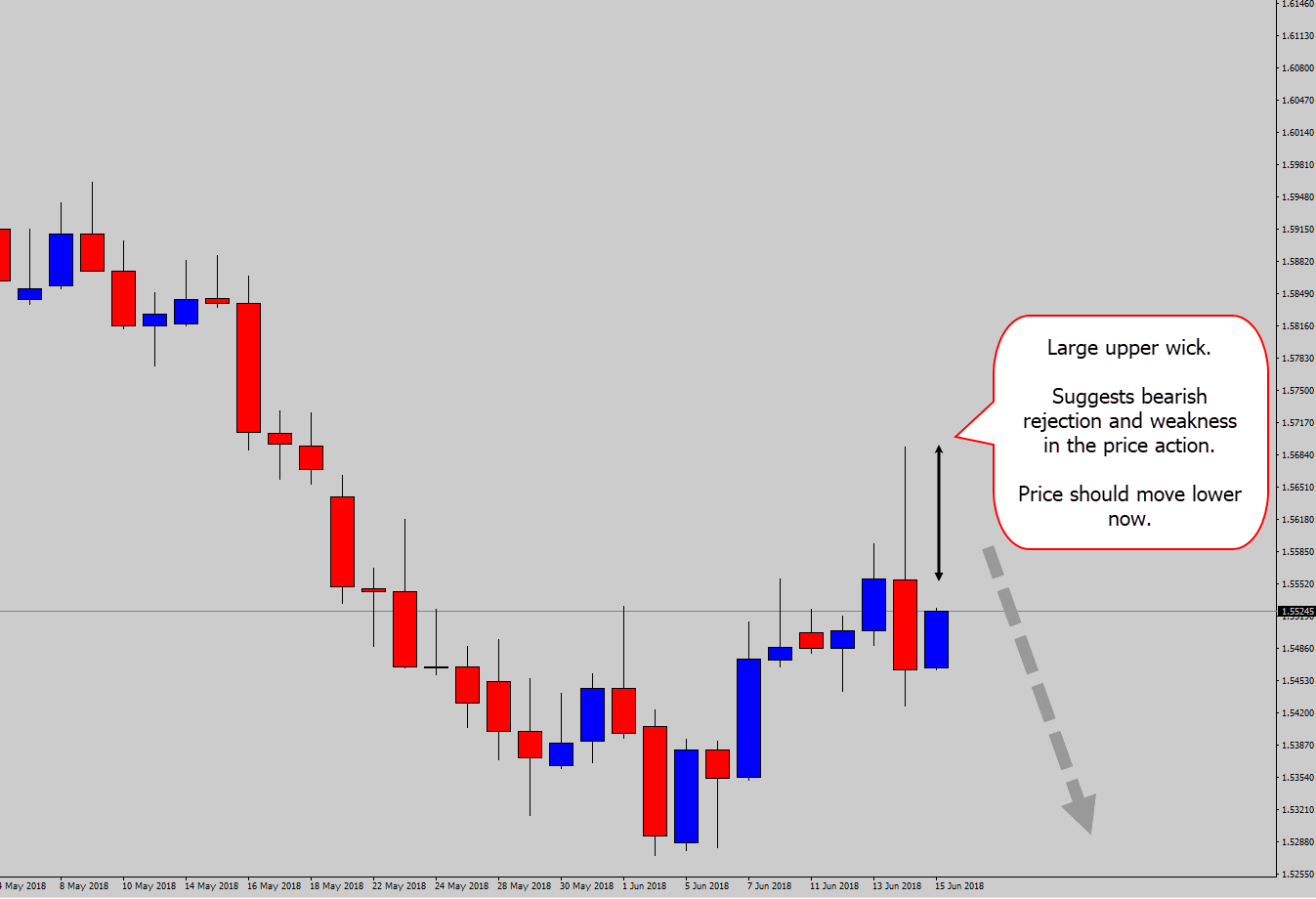
So based on what we’ve seen so far, this long wicked candle paints a pretty clear picture to where price is heading.
With an upper wick like that, the market is going to move down, right?
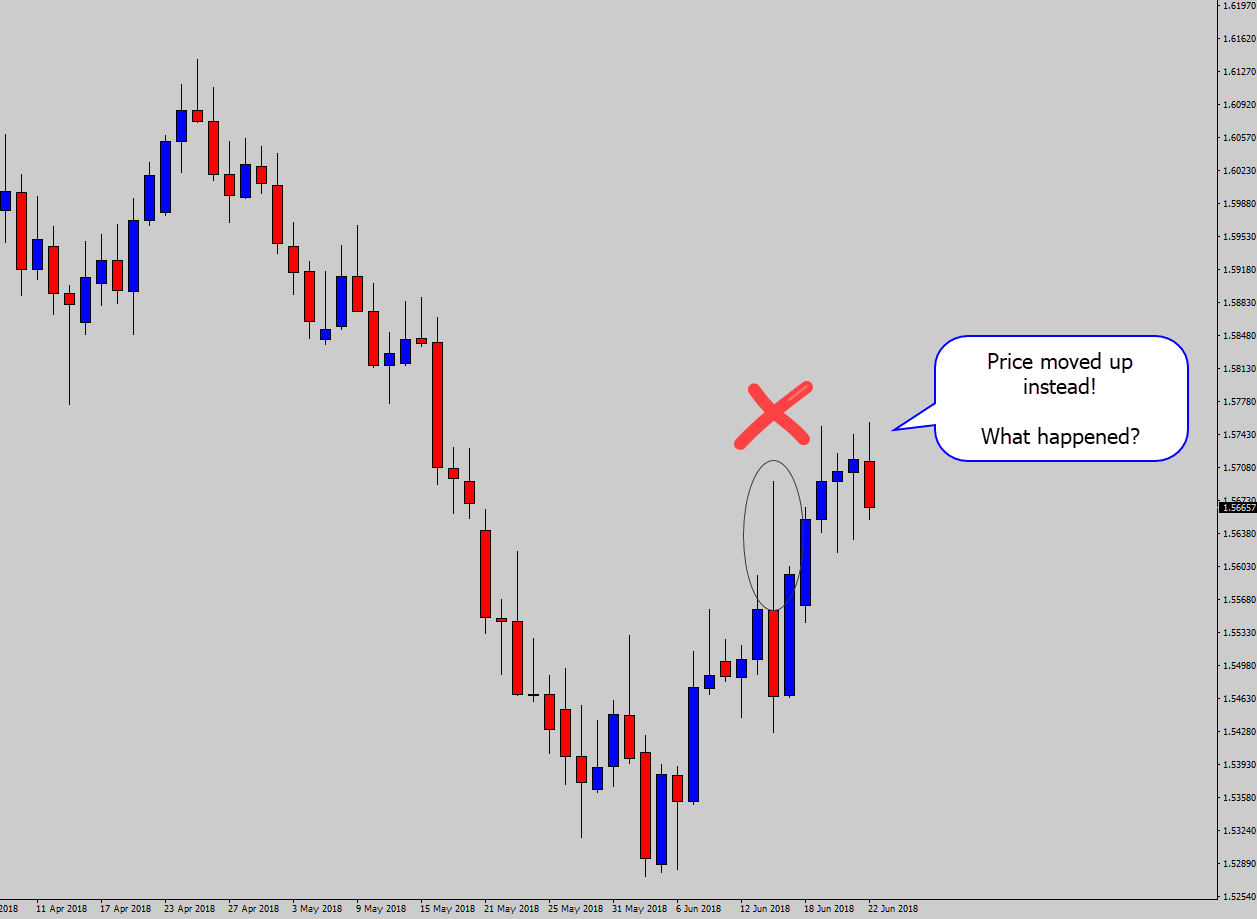
Nope, the market didn’t follow through with our expectations!
What happened? Well, welcome to Forex trading – where nothing is guaranteed.
That’s why “risk management” is a huge part of your trading education, to prevent big losses on our accounts when things don’t go expected.
I just wanted to break the flow of winning trade examples here so I don’t paint a picture of the promised land, and keep things in-line with actual real trading conditions.
Large wicked candles are very popular, they can produce very profitable moves – but they don’t have a 100% win rate.
It helps when you combine the large wicks with other strong technical features from your chart analysis to build a logical trade idea.
Checkpoint
Candlestick Patterns for Price Action Breakout Strategies
The two candlestick breakout trade setups I focus on are:
- The inside candle breakout
- The indecision doji breakout
These guys are more of a catalyst rather than a direct price action signal.
We look for them to form at important locations (identified by our price action analysis), and then get ready for the anticipated breakout.
An inside candle is defined by it’s range sitting completely within the previous candle’s range. That includes it’s high and low price.
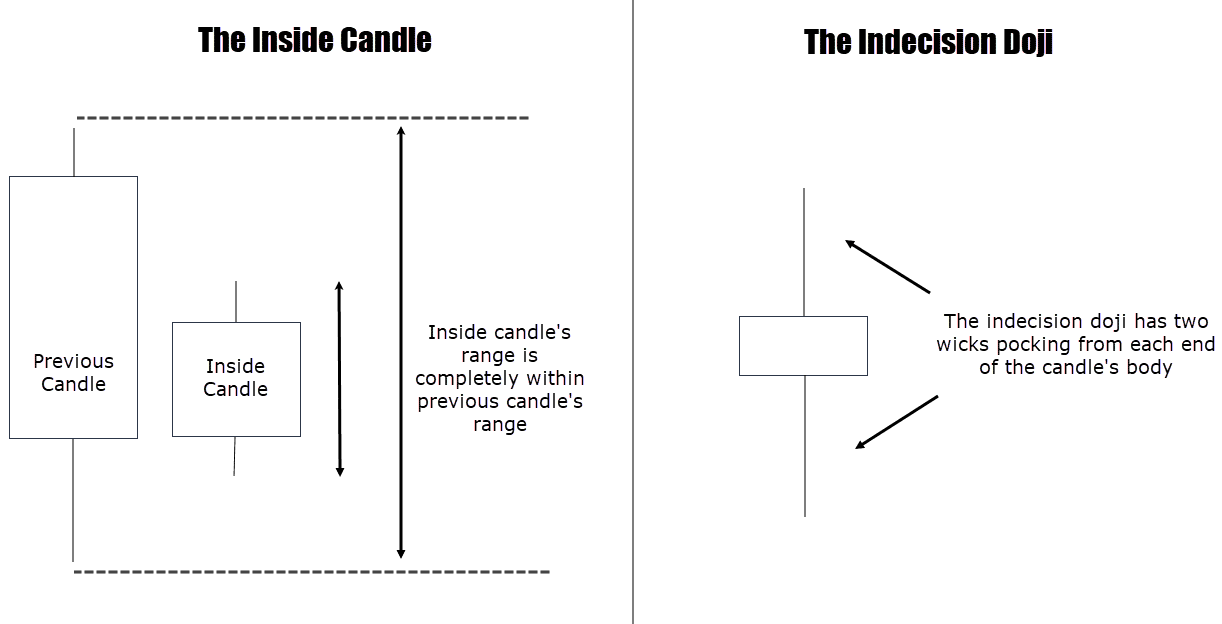
The doji candle is easily spotted with its double wick feature.
A wick that pokes out from each end of the centered candle body communicates an indecision period during that candle’s lifetime.
We can look to trade price breakouts from that indecision in the appropriate contexts.
Pro Tip: If you go out and trade every single inside candle and doji, you will get slaughtered!
When looking for candlestick breakouts, make sure they align with your chart analysis to give them the best chance of working out.
Below is an inside candle that formed within a bullish trending environment…
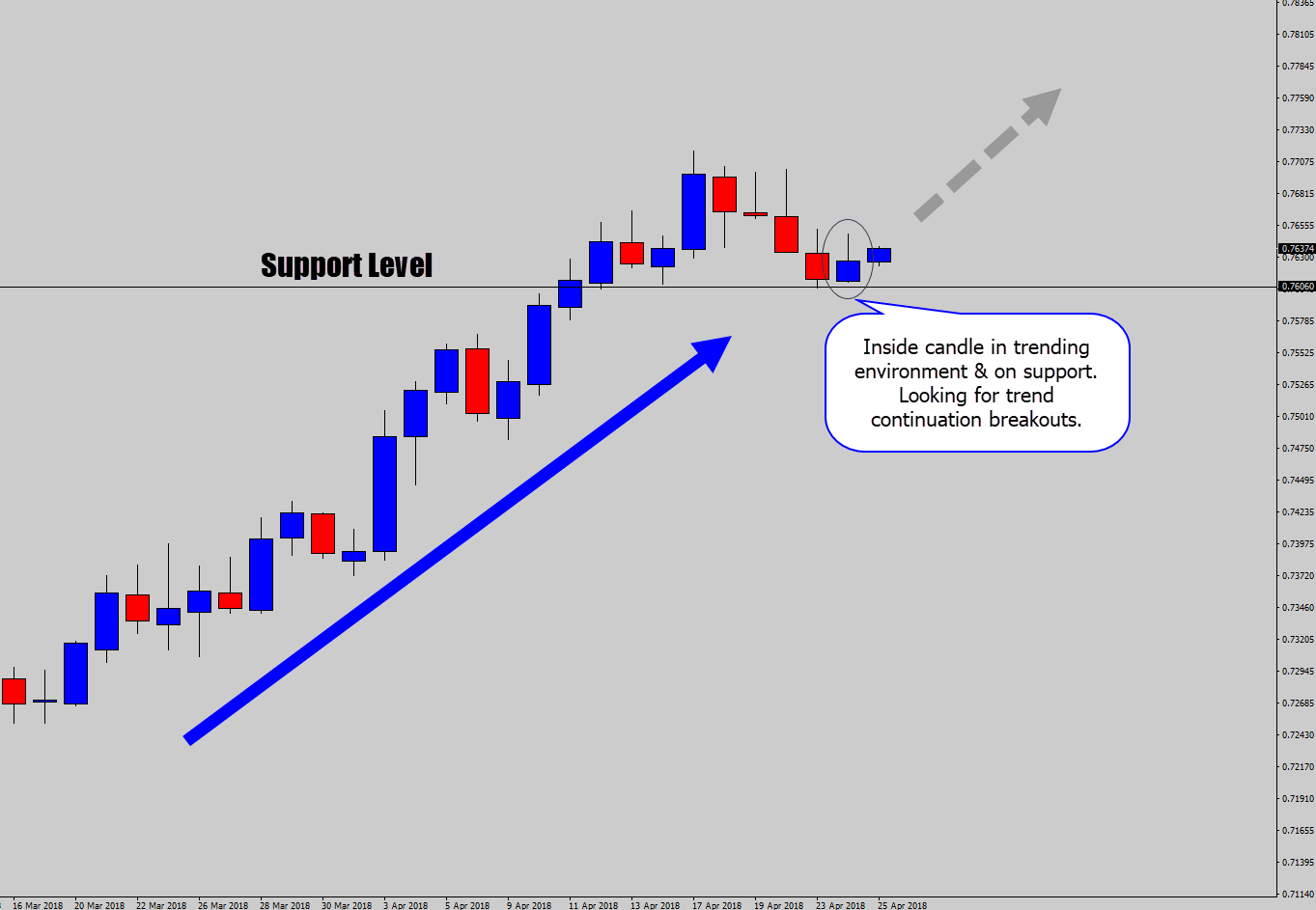
We’re looking for price to break the inside candle high to trigger the breakout event, confirm the trend is continuing to push up and get us in with the momentum.
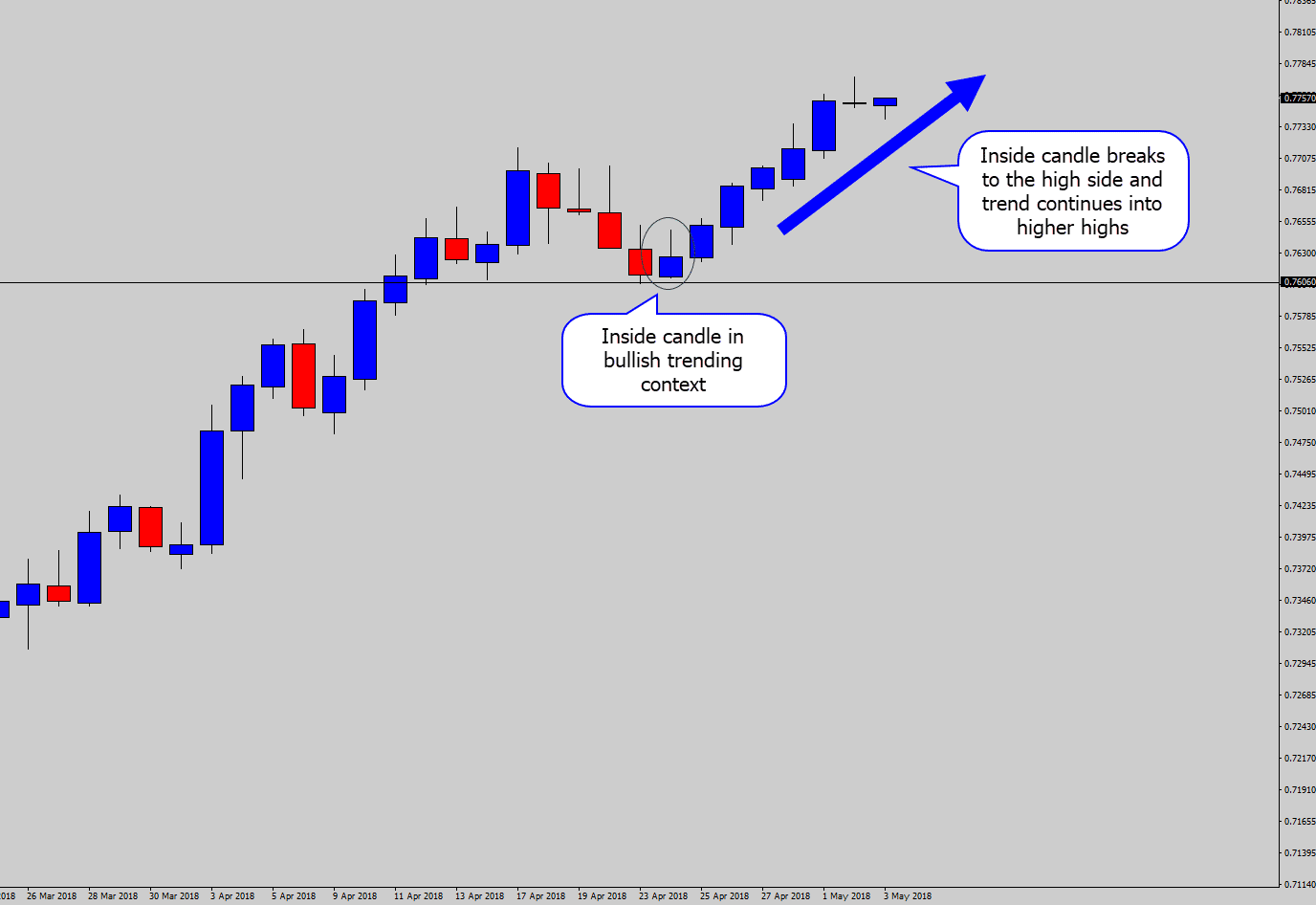
The inside candle high broke as anticipated, and the trend pushed on.
Notice how the inside candle was also resting on a support level within the trend – the more value you can add to the breakout idea, the better.
Context is very important when trading breakout patterns!
Don’t try these trade breakout style setups if these is no context to trade with…for example:
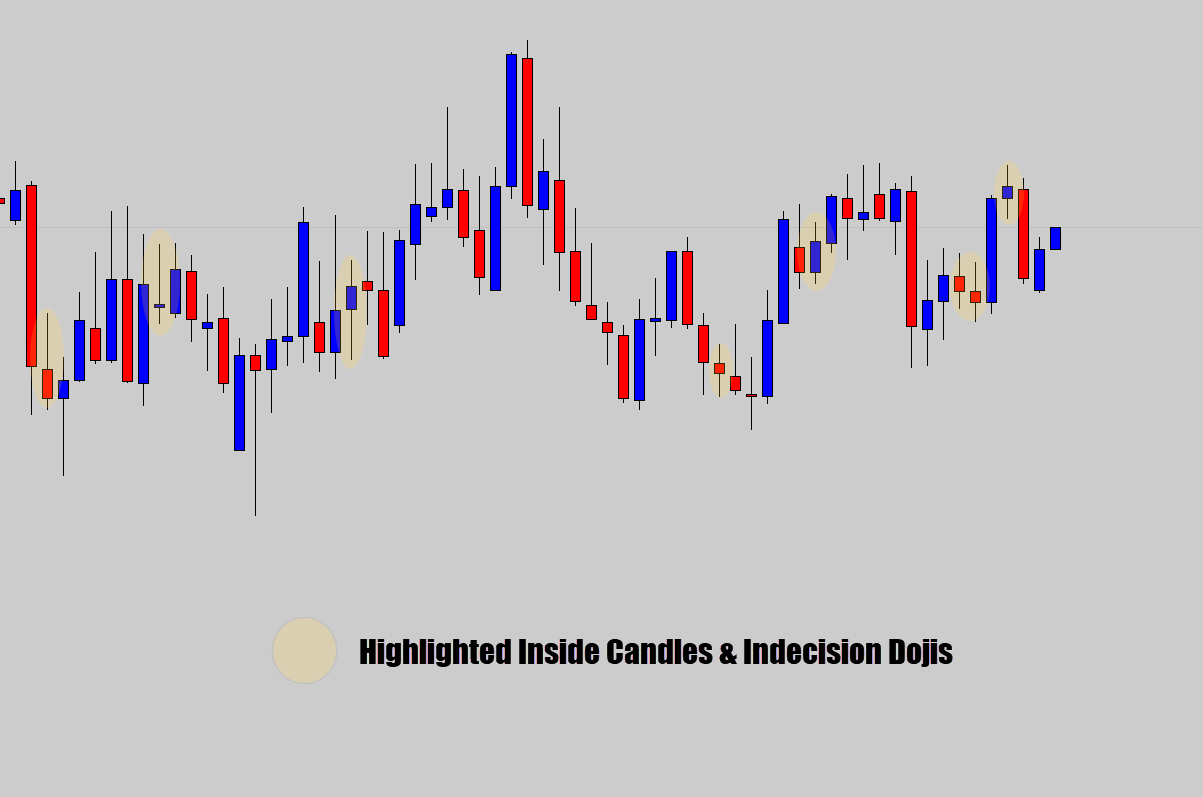
In the chart above, we have no context to be trading breakouts – it is a sideways, or ‘neutral’ market. It doesn’t make sense to trade a breakout in the middle of a high traffic zone.
All the inside candles and indecision doji patterns have formed in very dangerous conditions. Breakout trading is really risky here with no momentum.
Don’t forget your chart analysis should always come first.
Trading indecision breakouts is no different. Find locations on the chart where you expect the market to make a reversal – then look for the signal and trade the breakout in the direction of the reversal.
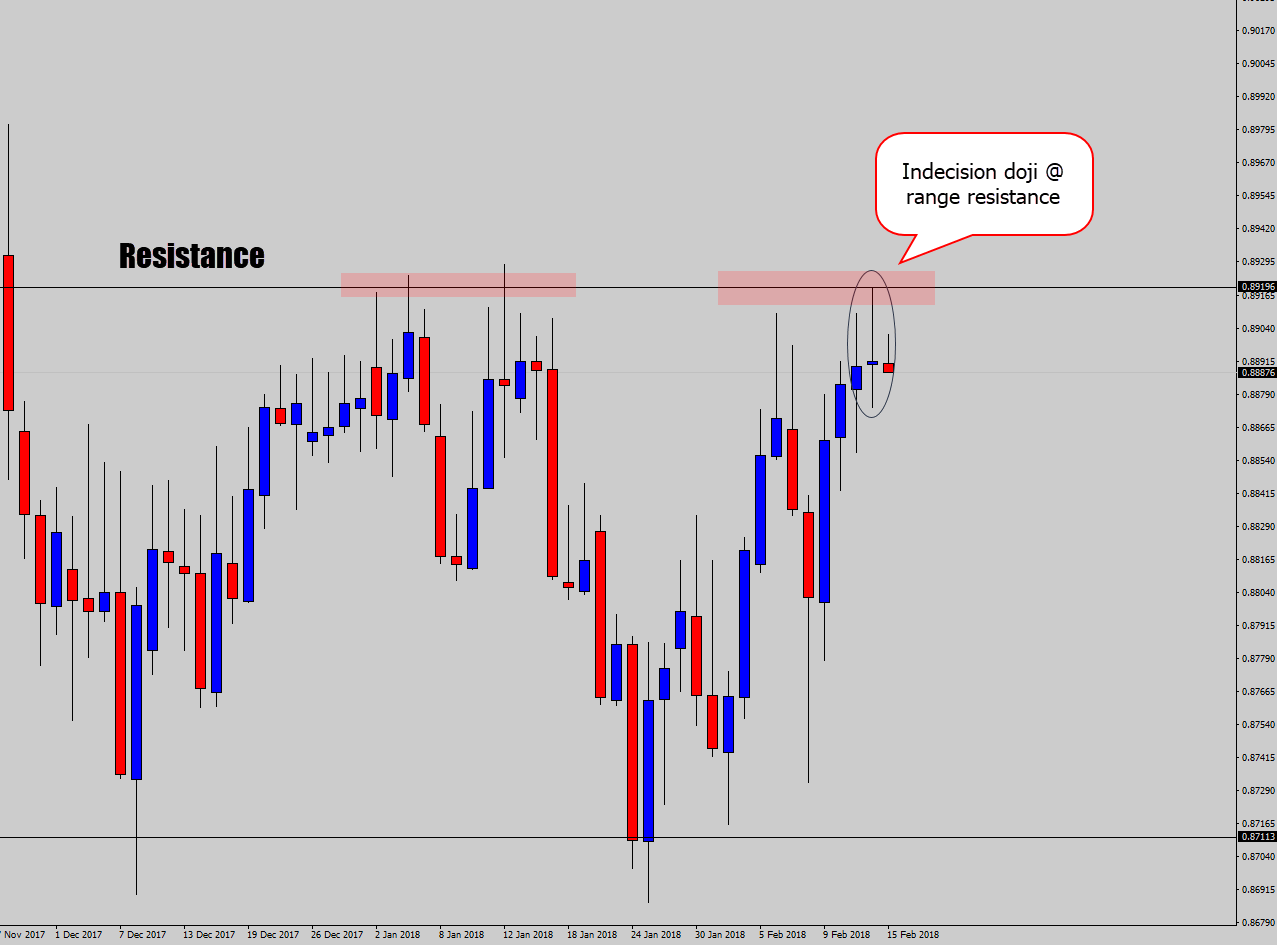
Above, we see a doji form at a very convenient technical location – the range top resistance level.
If the market is going to reverse, we are looking to catch the breakout from the indecision to the downside.
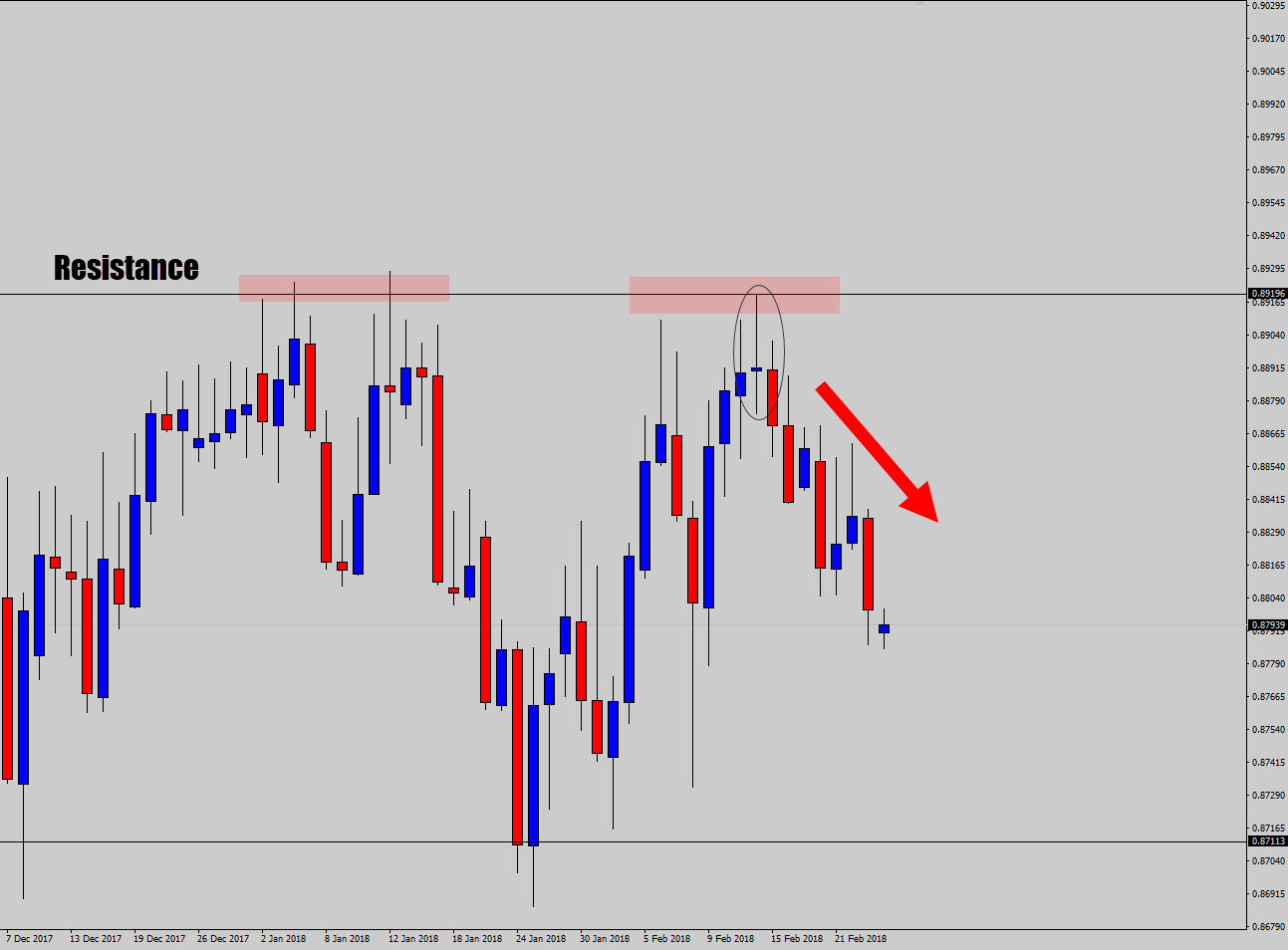
Boom! The market breaks the doji pattern low price, and the market drops for the next two weeks.
Checkpoint
Engulfing Candles “Overpowering Price Movement”
The third family of candle patterns is the engulfing candle, one that suggests a strong overpowering move in the market.
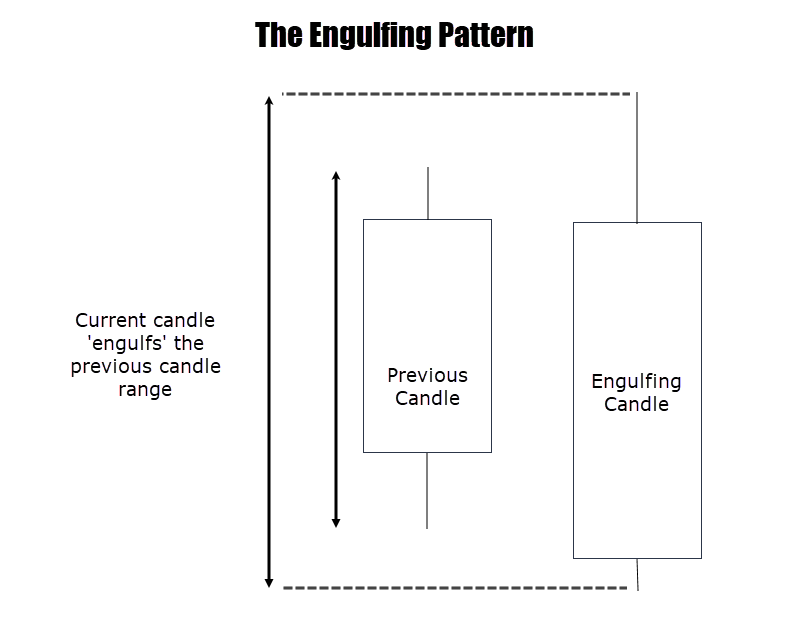
These will generally pop up on your charts when the market makes a strong, sudden move. The engulfing term comes from the sudden price action consuming the previous candle’s range.
What we want to do is try catch the follow through from the engulfing move…
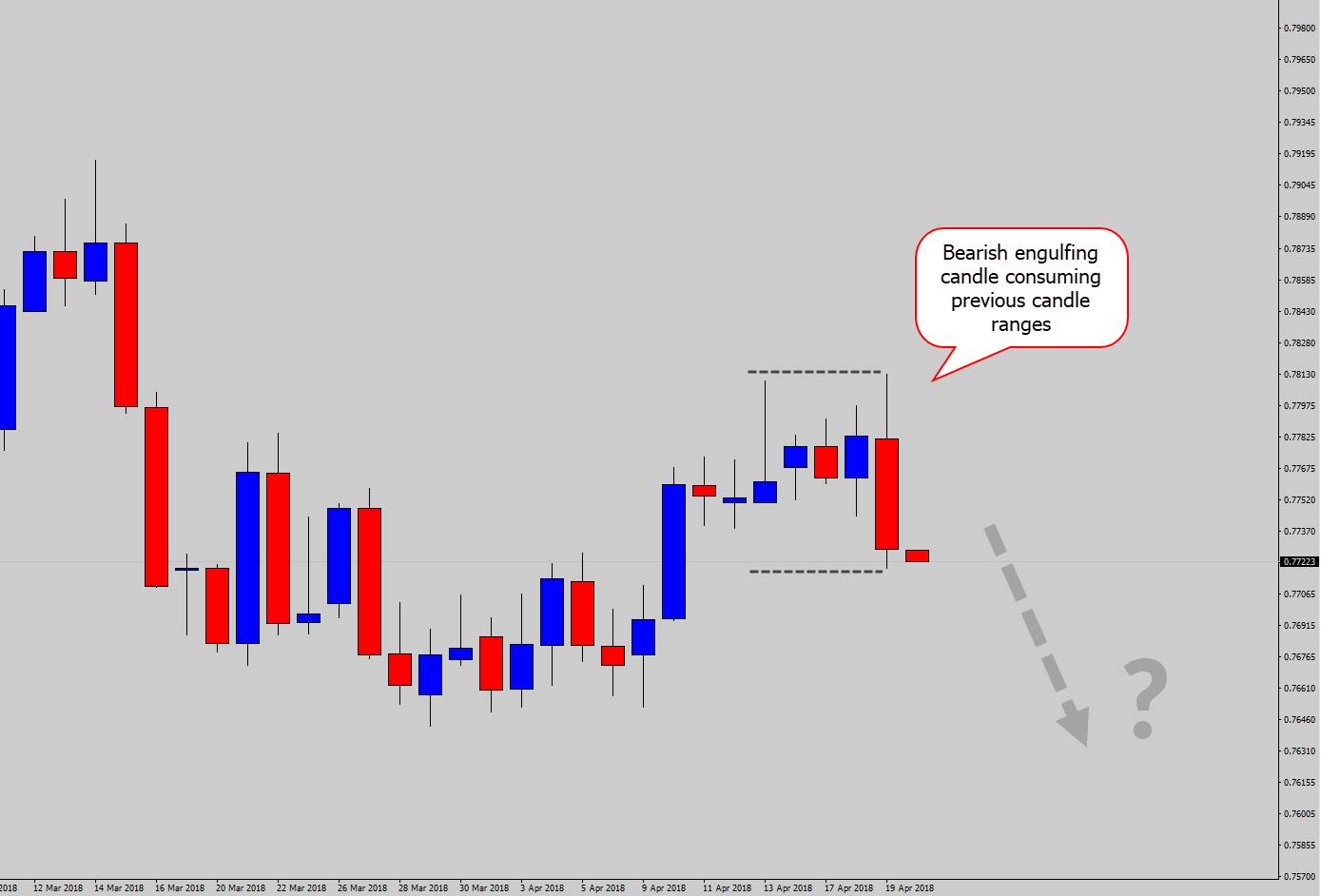
Above: A really strong engulfing candle. It even consumes multiple candle’s ranges before it.
This was caused by a decisive strong move in the markets, and we expect bearish follow through to continue…
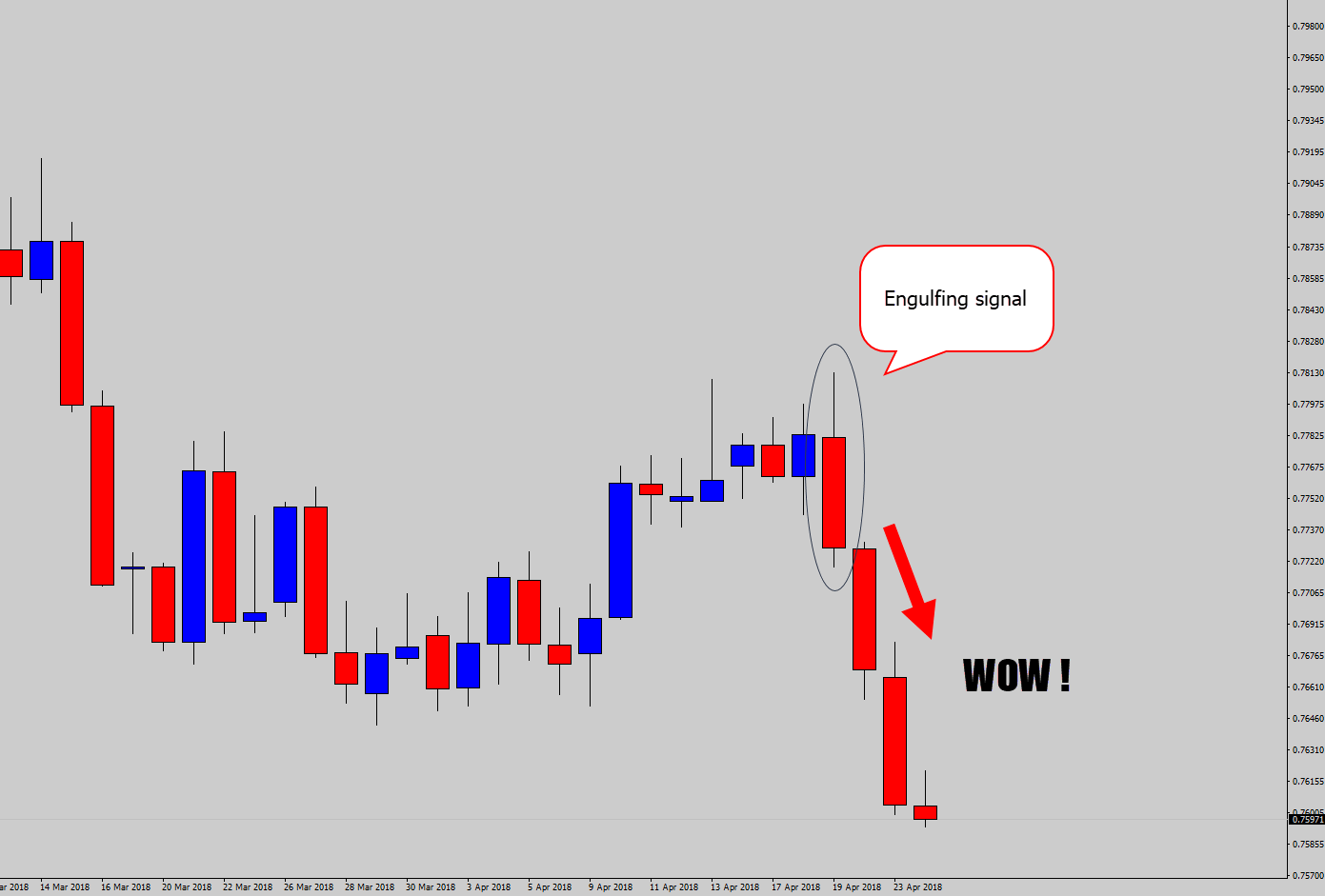
Above: As anticipated, the market dropped, but wow this was a strong move.
That’s the principle behind engulfing signals, we want to catch strong follow through moves from the initial strength/weakness that caused the engulfing pattern in the first place.
Below is an example of a bullish engulfing pattern on a support level…
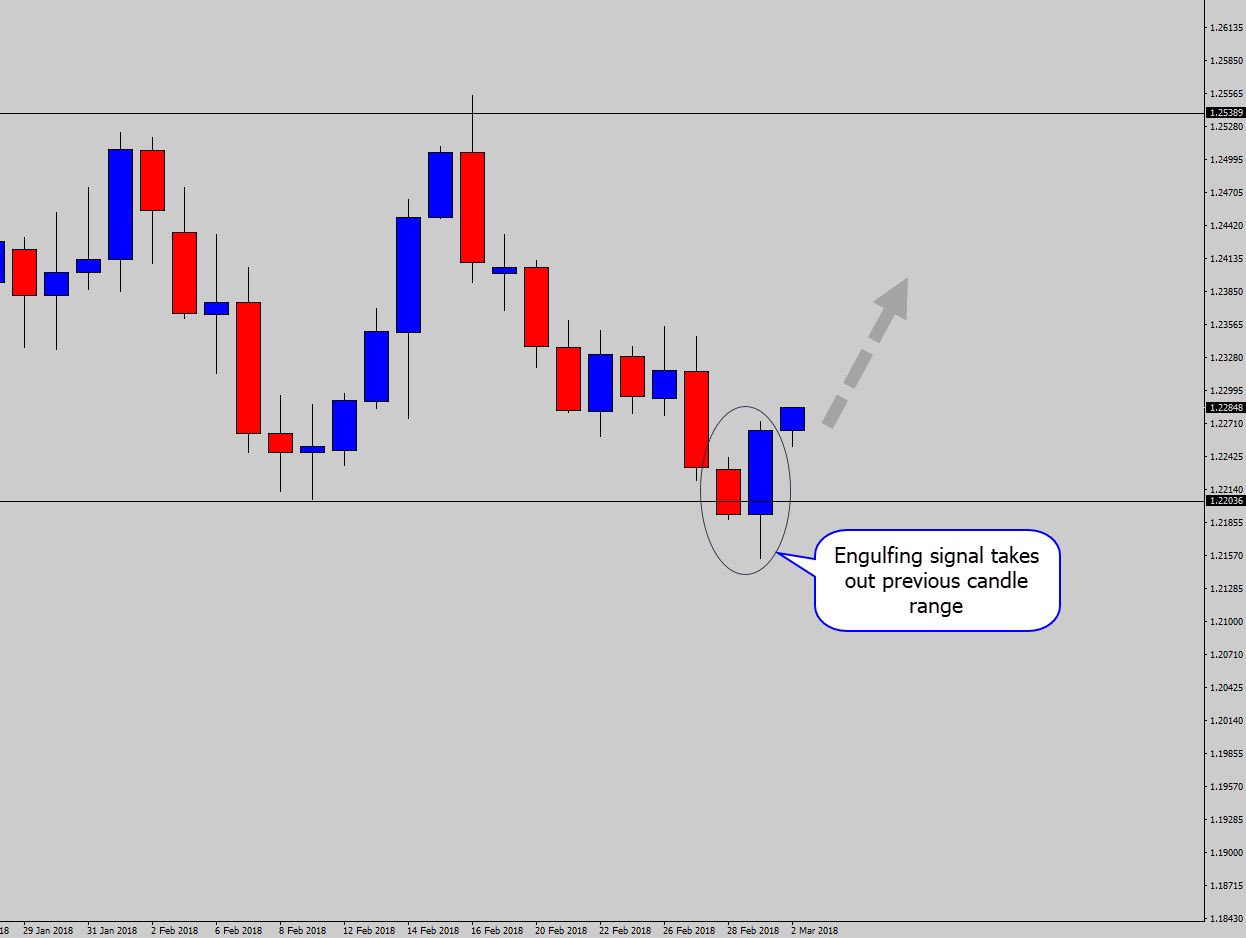
We have nice grounds to see a bullish move out of this signal. The market is bouncing strong off a range support – as a result the bullish engulfing was printed.
Most traders would probably be clearly long on this one, but then this happened…
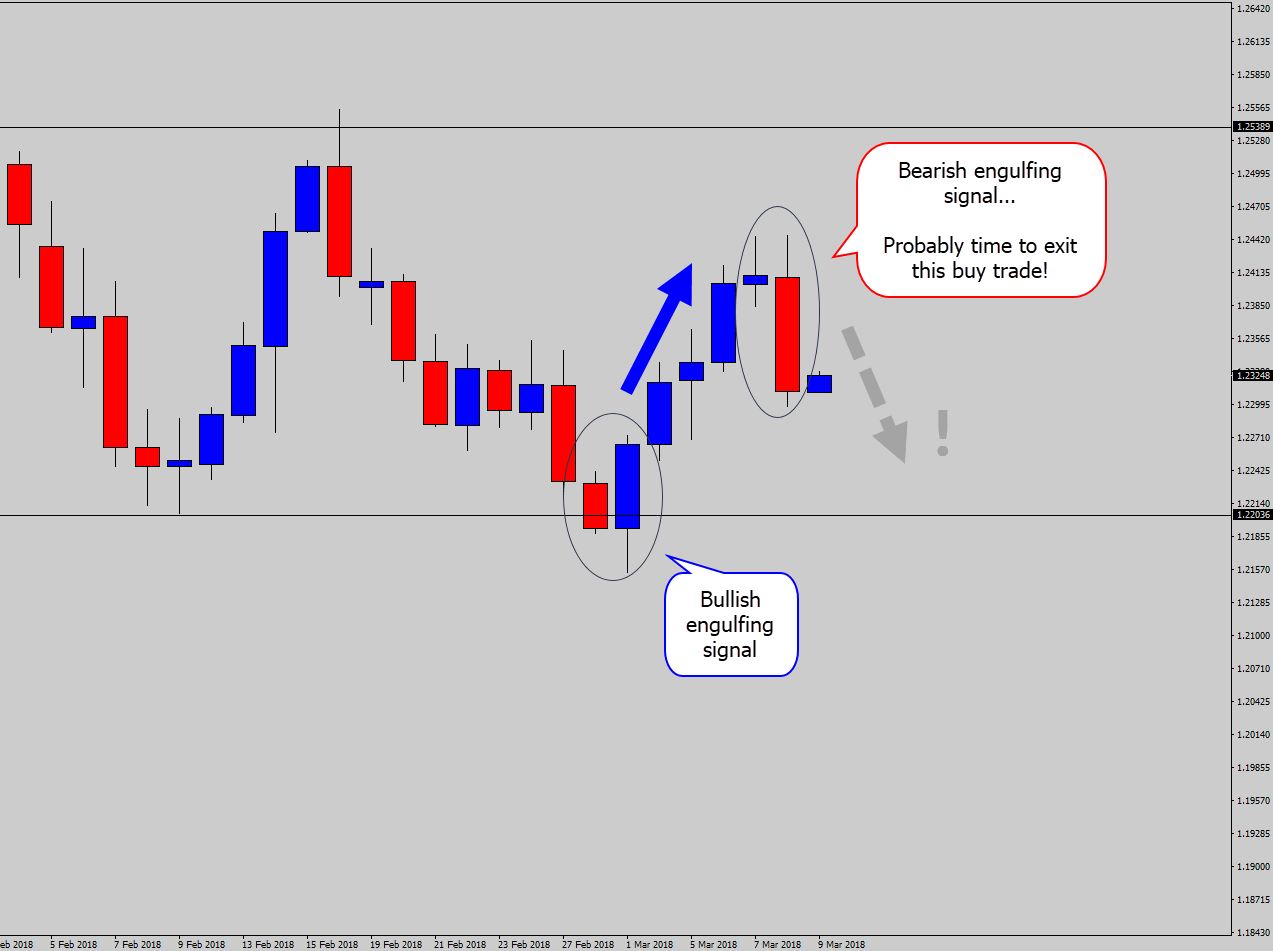
The market did follow through with the bounce, but wait – plot twist!
An opposing bearish engulfing candle printed while the bullish move was playing out. Now we expect the market to move down as it follows through with this big statement of weakness.
It would be wise to use this as an early warning exit signal for the initial buy trade, as lower prices are likely to follow, compromising your initial buy trade idea.
This does happen from time to time.
It is possible for the market to drop a really clear candlestick signal in the opposite direction. These can be an early tip to get out. But you need to make sure it’s a clear signal, don’t be spooked by smaller insignificant candles!
As I mentioned before, candlestick patterns are always part of a good price action based strategy – but other factors need to be taken into consideration before the patterns are considered as viable trading signals.
Is the candlestick signal in or out of context of your technical analysis ? Is it in or out of position of the trending environment?
Remember that candlestick buy/sell signals need to come as a ‘package deal’ with the rest of your technical analysis.
Checkpoint
A Ranging Market Price Action Strategy Made Really Simple

I like to keep things really straight forward and simple, and ranges are no exception.
Ranging conditions are when price is trapped between a support and resistance level, and is stuck bouncing between the two boundaries.
Below is a chart of what a typical ranging market looks like…
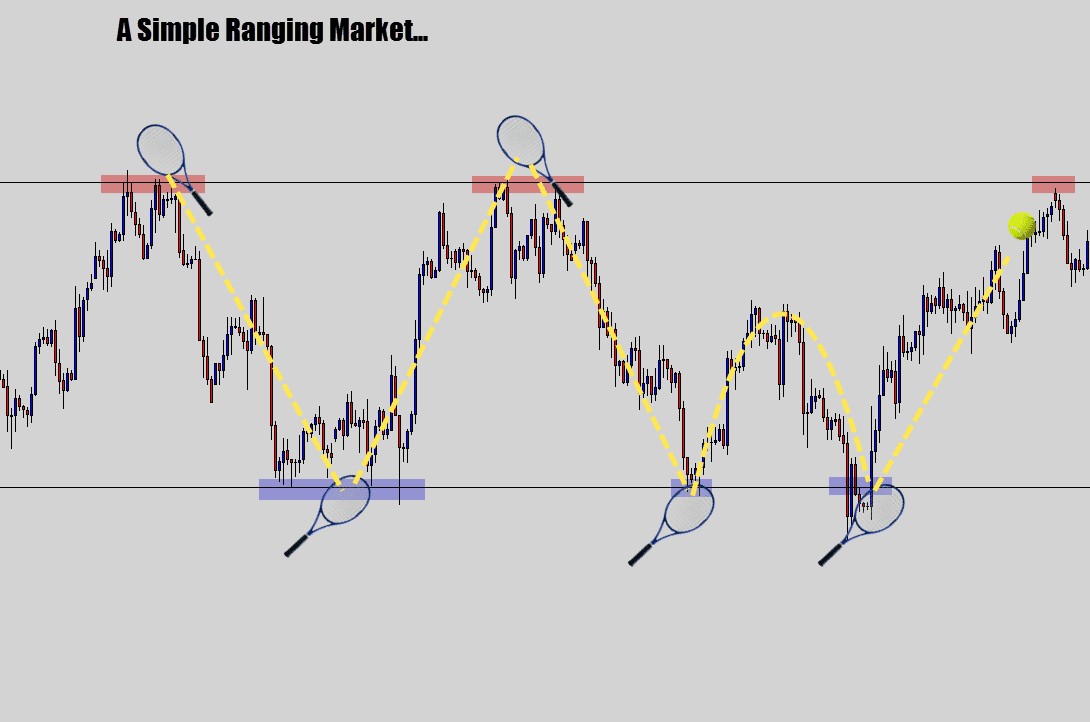
It is best practice to target the top and bottom boundaries for price action signals suggesting a bounce is likely to occur.
Take a look at the ranging market below…
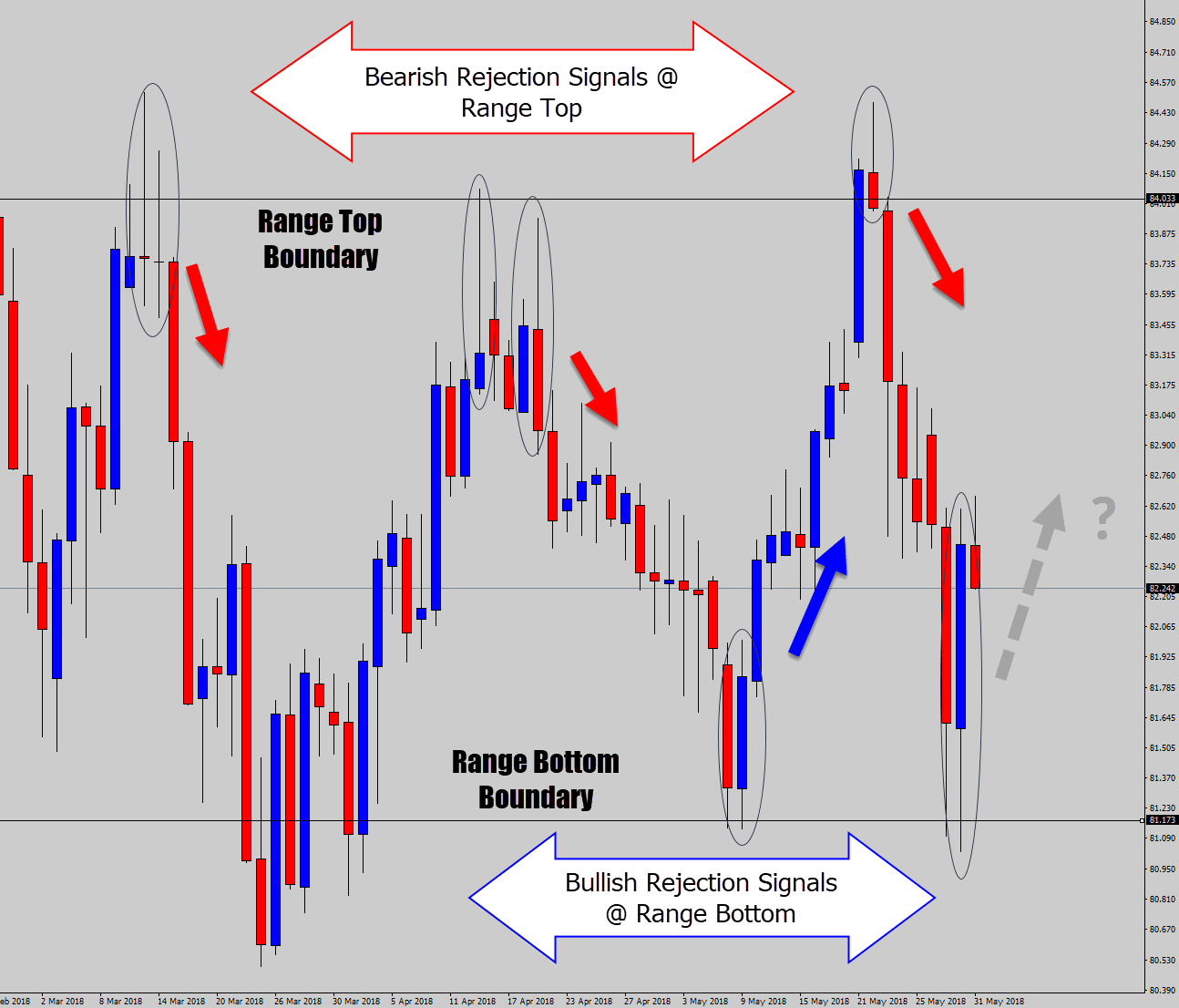
You can easily see this is a ranging market because we have the two clear boundaries which the price is bouncing between.
Notice all the bearish rejection signals at the boundary top, and the bullish rejection signals at the bottom suggest a ‘bounce’ off the range boundaries?
They represent an early warning signal to the next range cycle.
In the picture above, I’ve captured the moment where a large bullish rejection signal formed at the range bottom boundary. Where do you anticipate price is likely to move next?
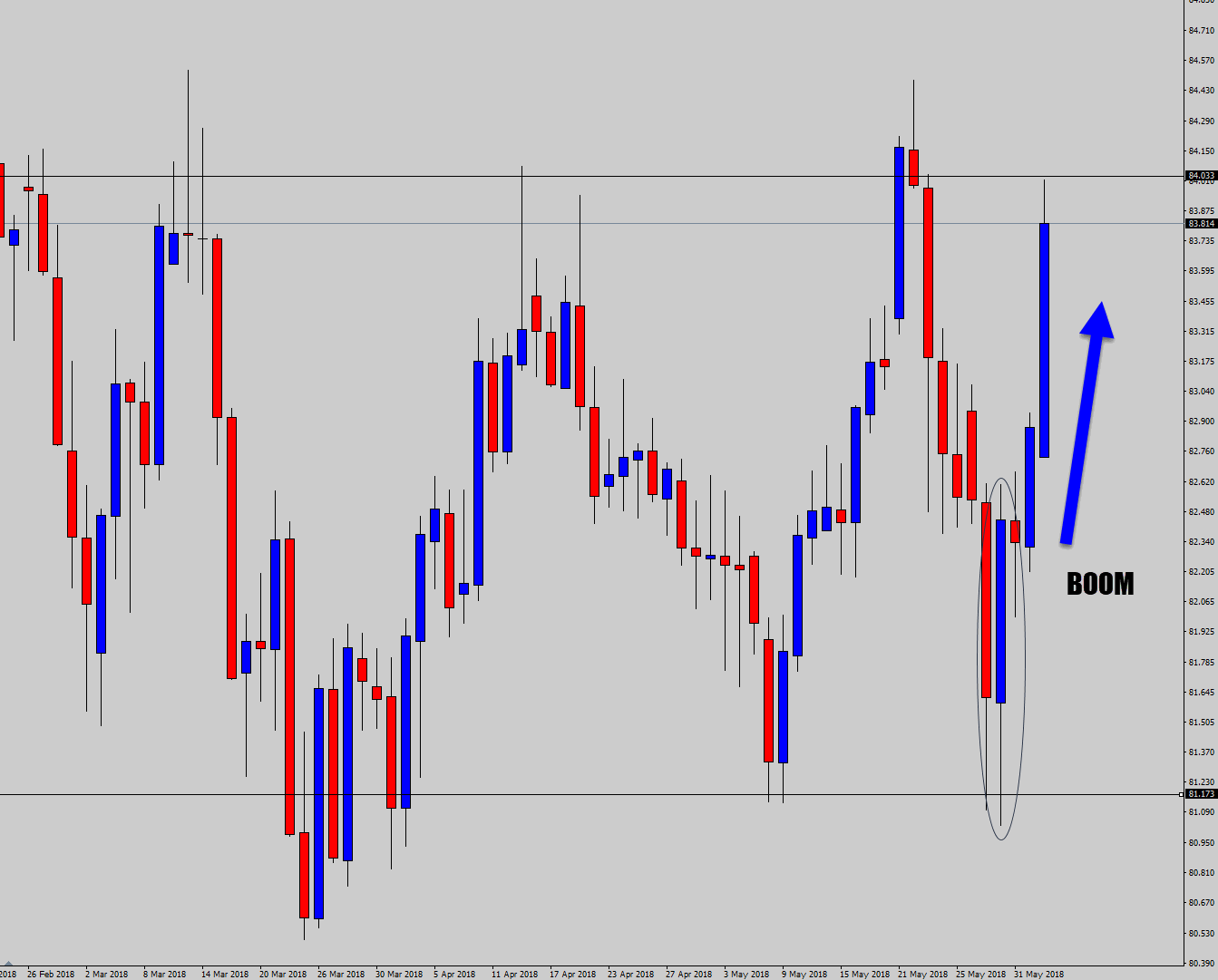
If you guessed up, you’re awesome.
It’s as simple as this, you trade the range boundaries for the best opportunities.
Attempting to trade range breakouts is a different story! It’s difficult – the market often tricks you around the range boundaries, giving the impression that it’s breaking out, when it’s really not.
This is called a breakout trap, or a “fake out”. Very common around the range tops & bottoms, even for experienced traders it is risky – so just stick to trading “bounces” on the range boundaries.
But what about in the middle area of the range? Whoa be careful – that’s a minefield also…
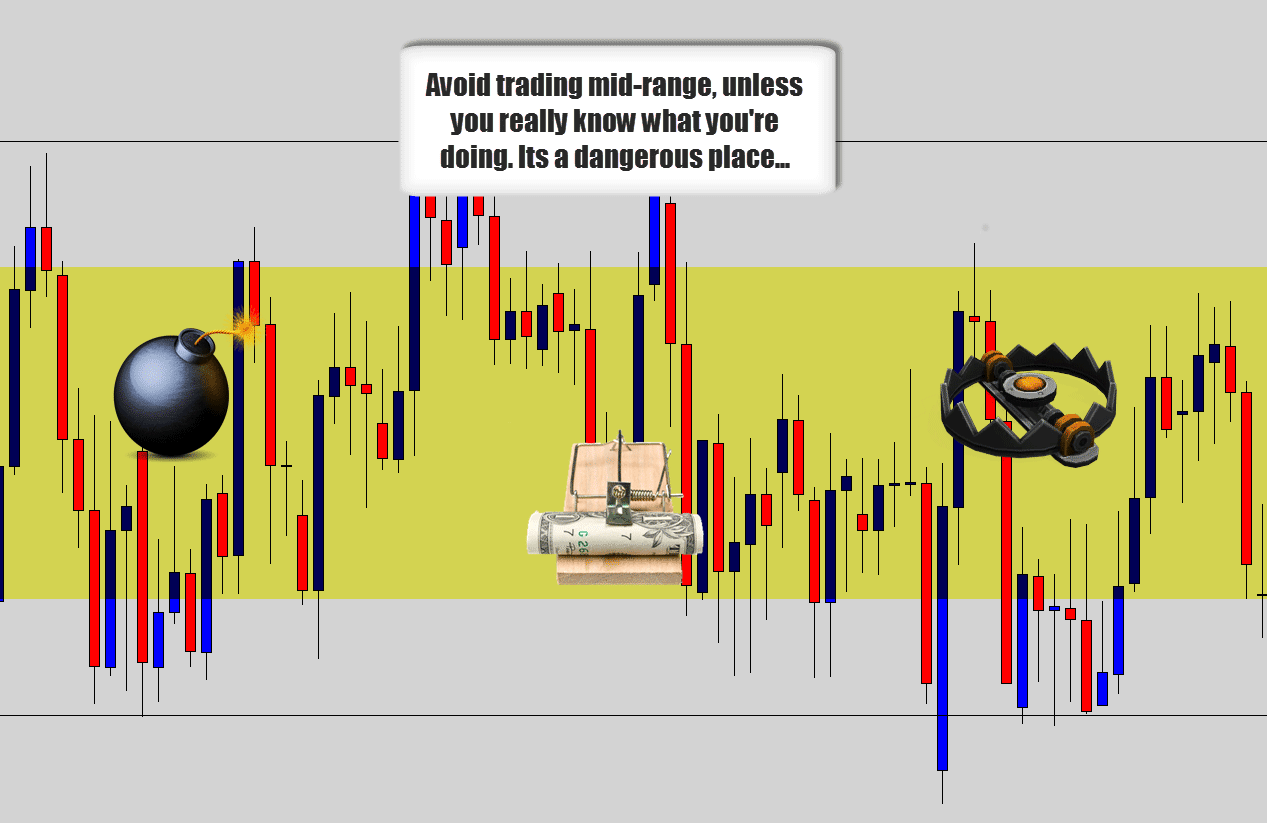
Look at some example signals below that formed mid range…
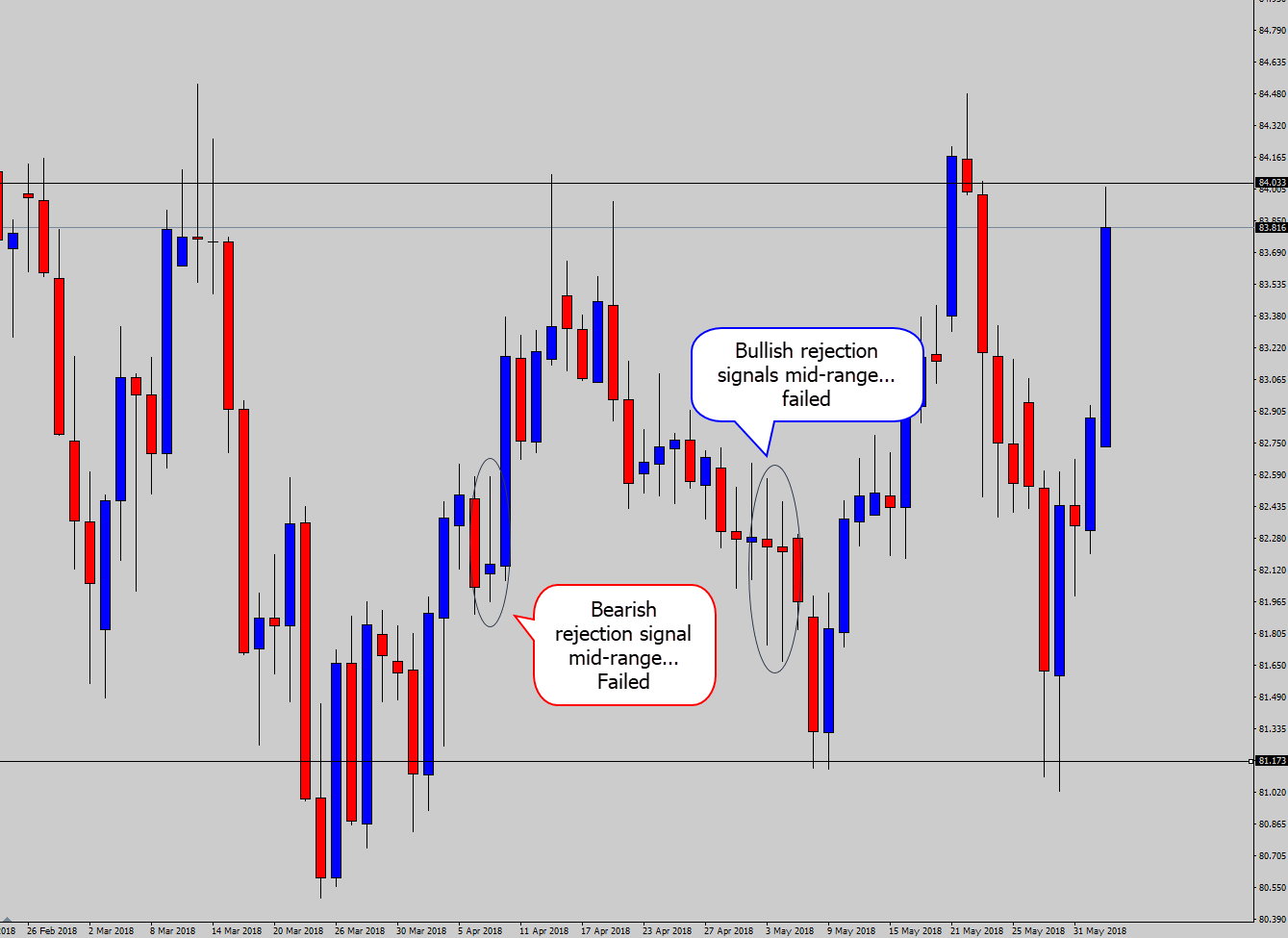
When you trade in the middle of a range you’re dancing in fire.
Ranges are simple, don’t make them any more complicated than they need to be.
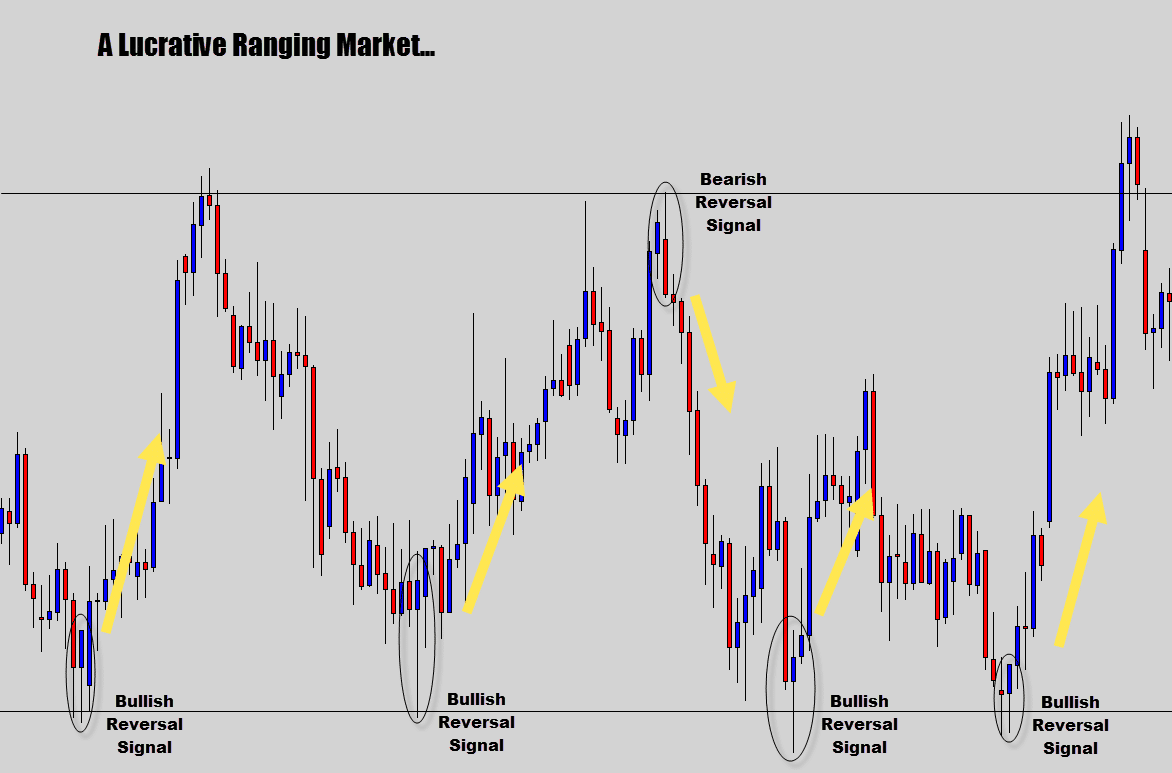
Checkpoint
The Secret to Identifying Trends and How To Trade Them

How do you determine the trend? A question that’s always over-analyzed and taken out of context, especially in public discussions.
Because of the mass confusion, no one has the concrete answer. But here it is…
You need to look at the footprint of the swing highs and lows.
- A bullish market will make higher highs, and higher lows
- A bearish market will make lower highs and lower lows
A bullish trend…
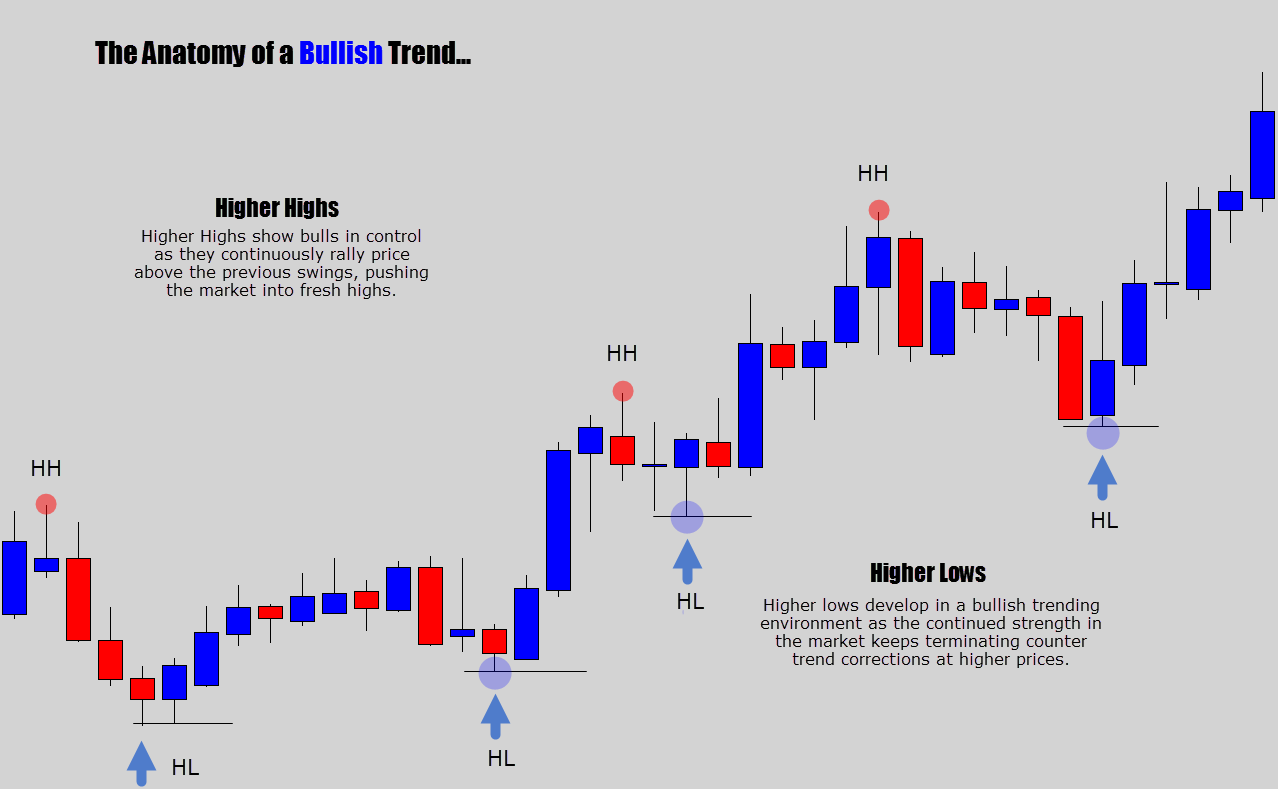
A bearish trend…
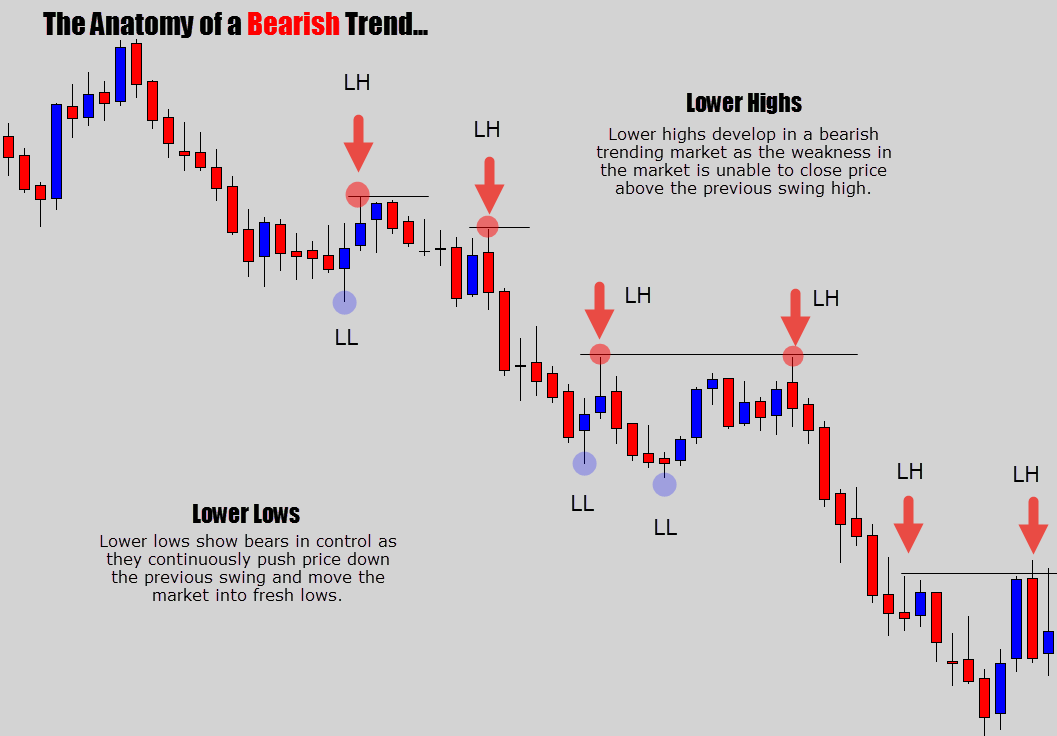
If you don’t see that pattern, then the market has probably stopped trending, or wasn’t trending to begin with.
You can also watch the swing points to isolate moments when the trend is changing direction…
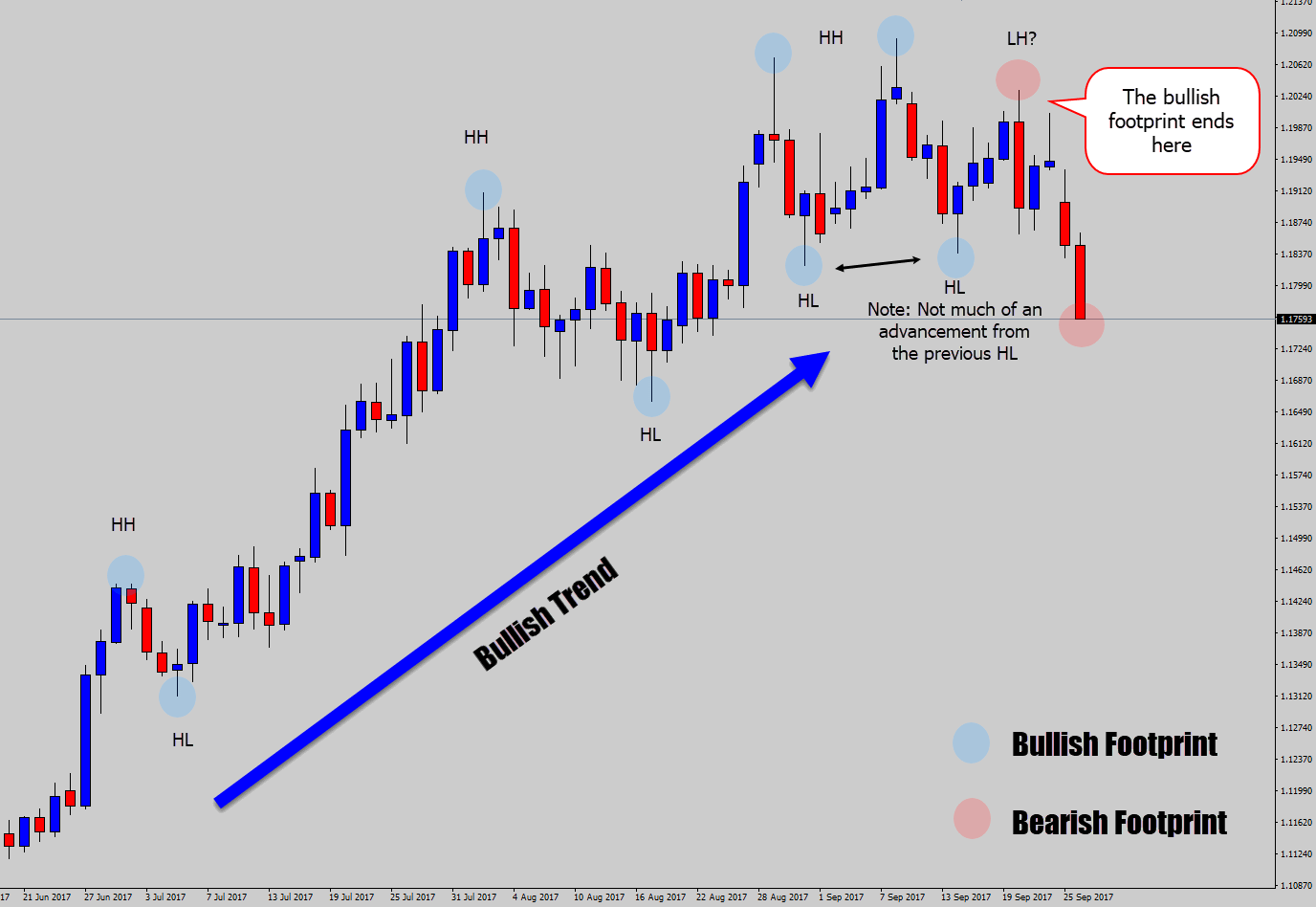
Above: The bullish higher low, higher high structure defining the bullish trending conditions.
There are warning signs of trend slow down in the swing point sequence. In this example, the strong higher low and higher high progression has started to slow down – signalling trend exhaustion.
Following the slow down, signs of weakness start to appear. Hmmm… A bearish trend now emerging? The price action gives you first hand warnings.
Noticing these subtle details are what will make you stand above the rest in the technical analyst world – nobody is paying attention to these finer details!
For good measure here is a bearish trending example…
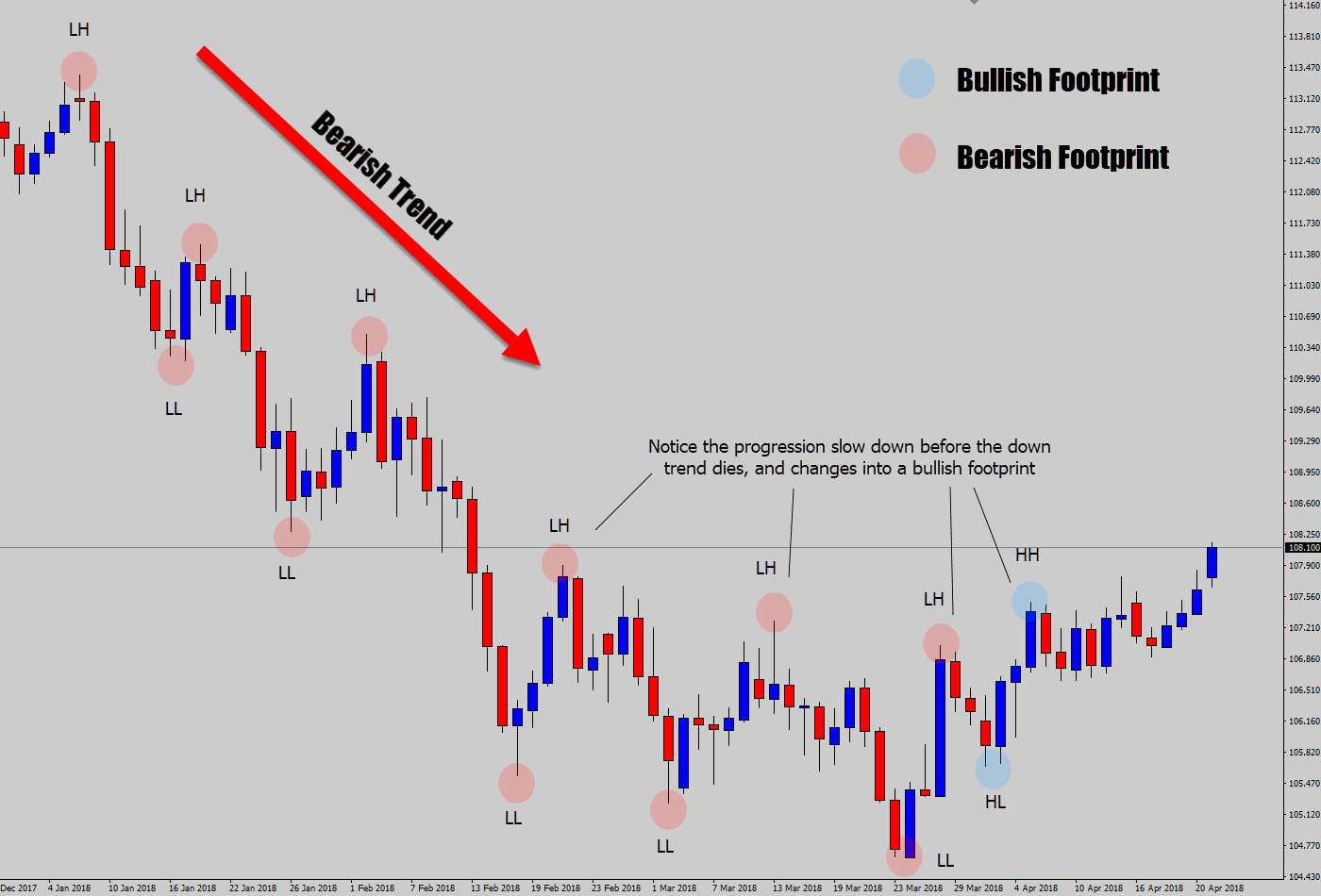
I often find traders use indicators to try highlight trend direction – there is no need, all the great information is right in front of you already.
Swing point analysis is the best way to find the trend, but the value doesn’t stop there – you can also read the trend’s health as well and pinpoint ‘hot spots’ for reversals.
Now ‘finding the trend’ has never been easier!
The ‘golden rule’ of trading (or any market place) is to buy low and sell high. Sounds simple enough, buy why do I still see many traders buying at extreme highs, or selling extreme lows?
When traders do the opposite (buy high and sell low), this happens…
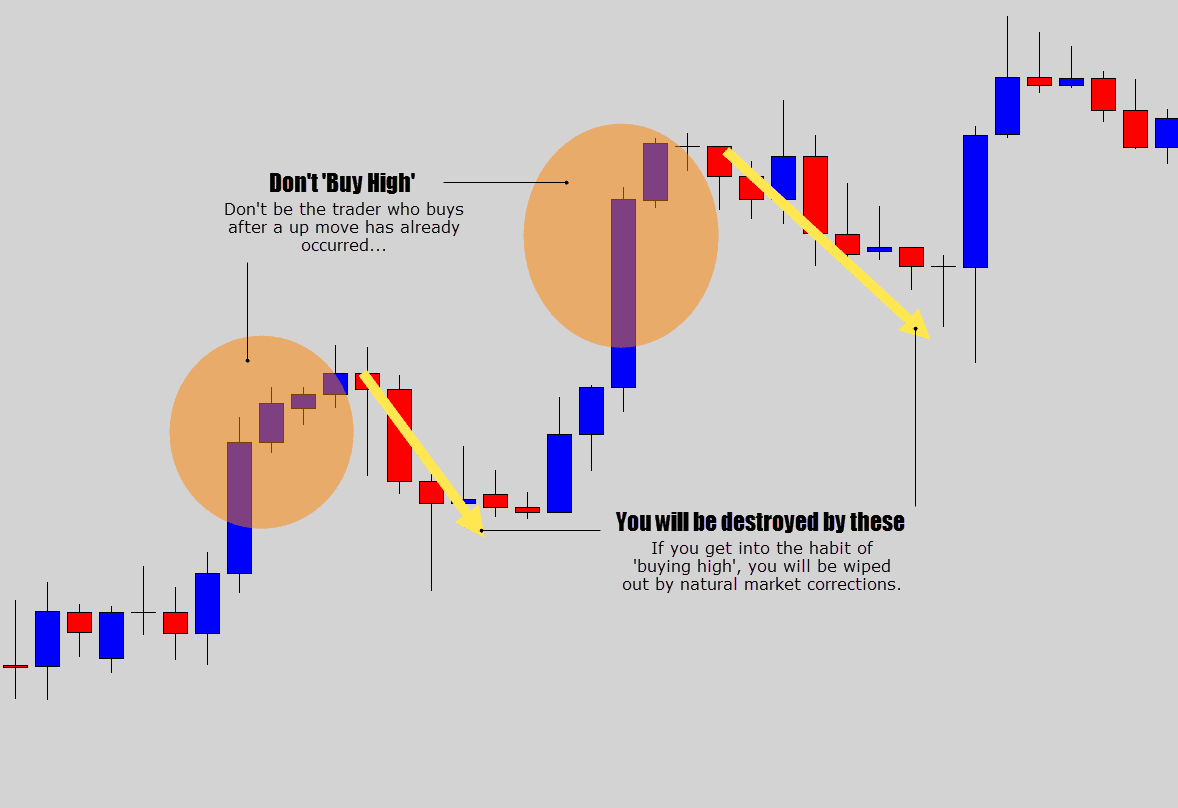
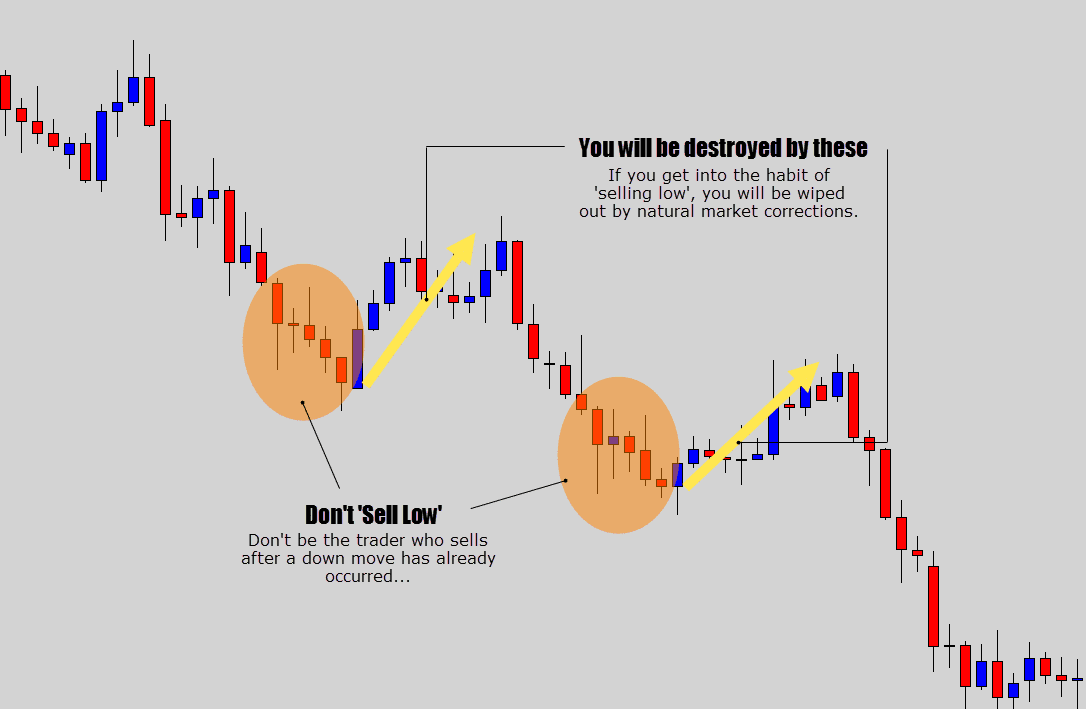
Remember: “Buy the dips, and sell the rallies“.
This famous industry quote says it all regarding how to position yourself into a trend correctly, and avoid the chance of being taken out by corrections.
Look for selling opportunities when the market is showing temporary strength in a bearish downtrend, or watch for buying opportunities when a market is showing temporary weakness in a bullish uptrend.
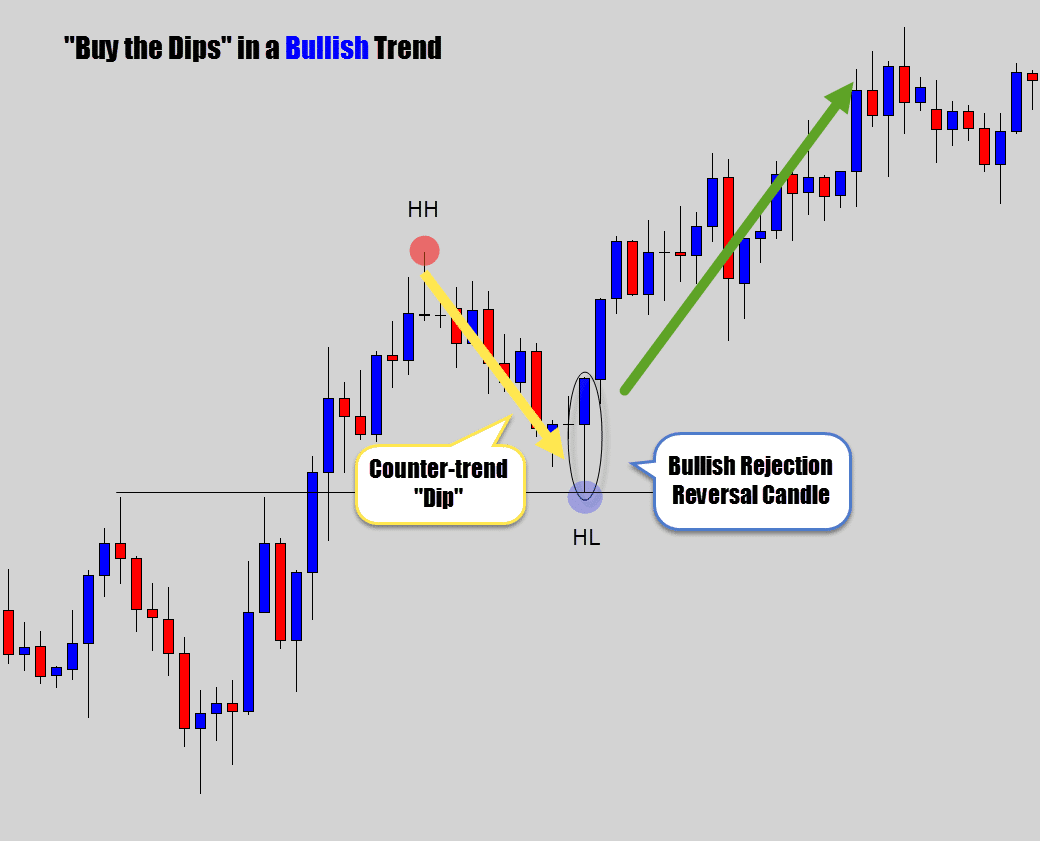
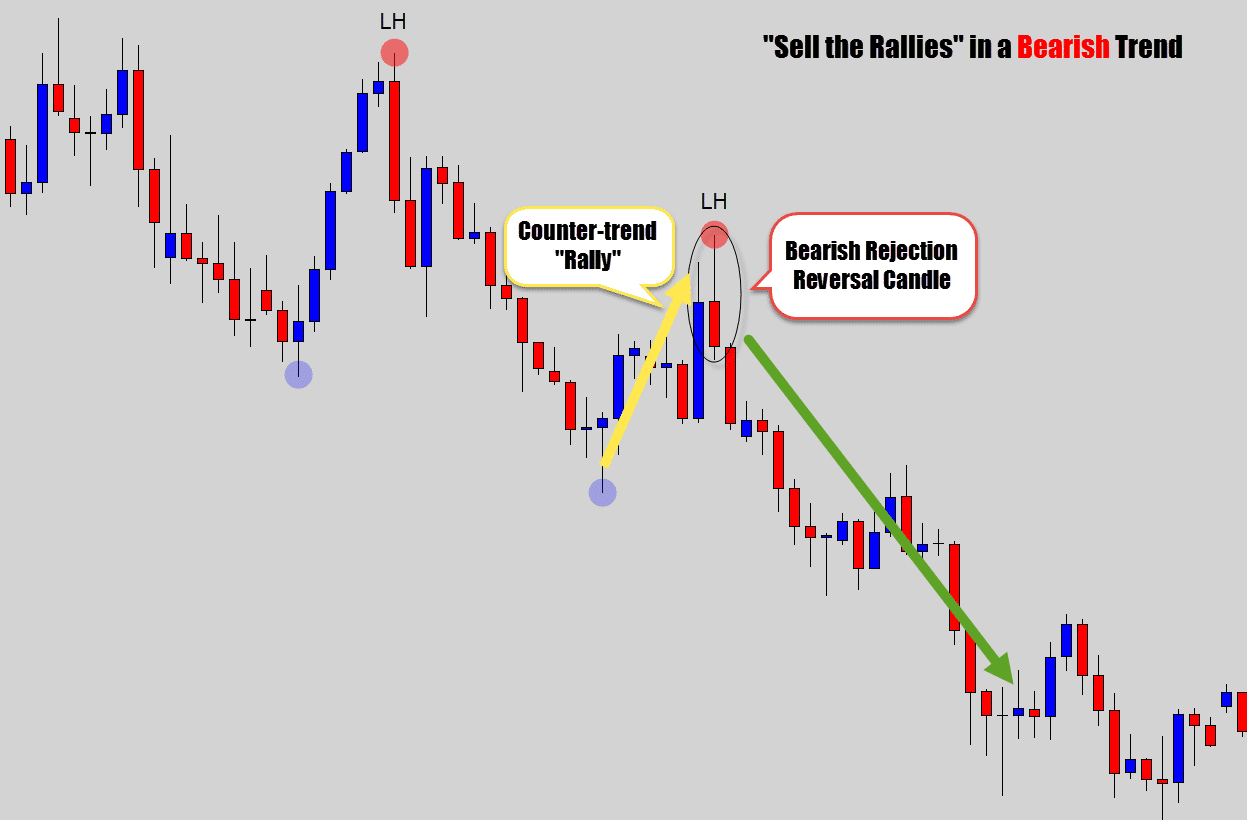
Sometimes, it’s important to go back to the basics and identify what a trend really is.
That’s why price action is the best way to evaluate a market’s structure. You can quickly see if there is a trend or not.
A trend is just a ‘stair-stepping market’, and a stack of exotic indicators are not needed to give you directional information – just use the core trend rules from this lesson to identify the real trends on your own charts.
Checkpoint
More Patterns For The Resourceful Trader
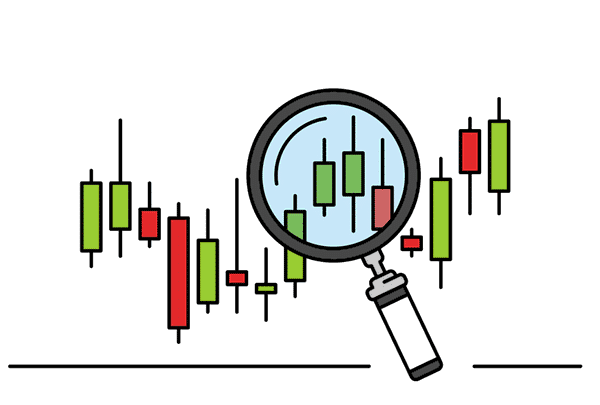
There is an almost an infinite way to view price action – the technical trading world is always coming up with new strategies and systems.
One can look beyond isolated candlestick signals, and look for price action patterns.
Squeeze Breakout Strategy
Markets often consolidate, sometimes it’s a messy minefield, other times there is some structure to it.
The squeeze pattern – identified by declining highs, and rising lows “squeezing” price into a triangle shape, sometimes referred to as wedges.
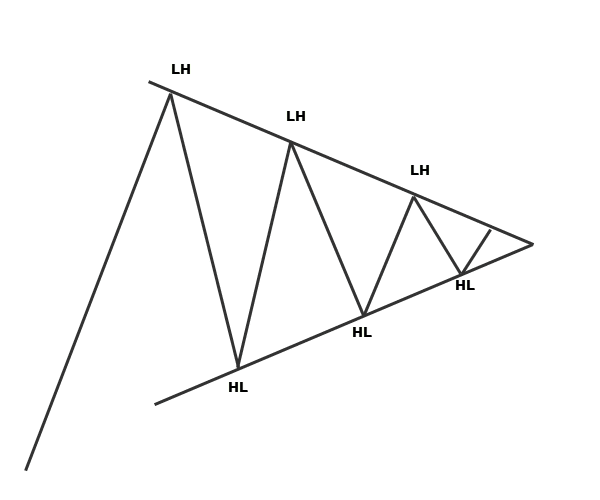
The “squeezeing” action here is caused by declining highs, and rising lows.
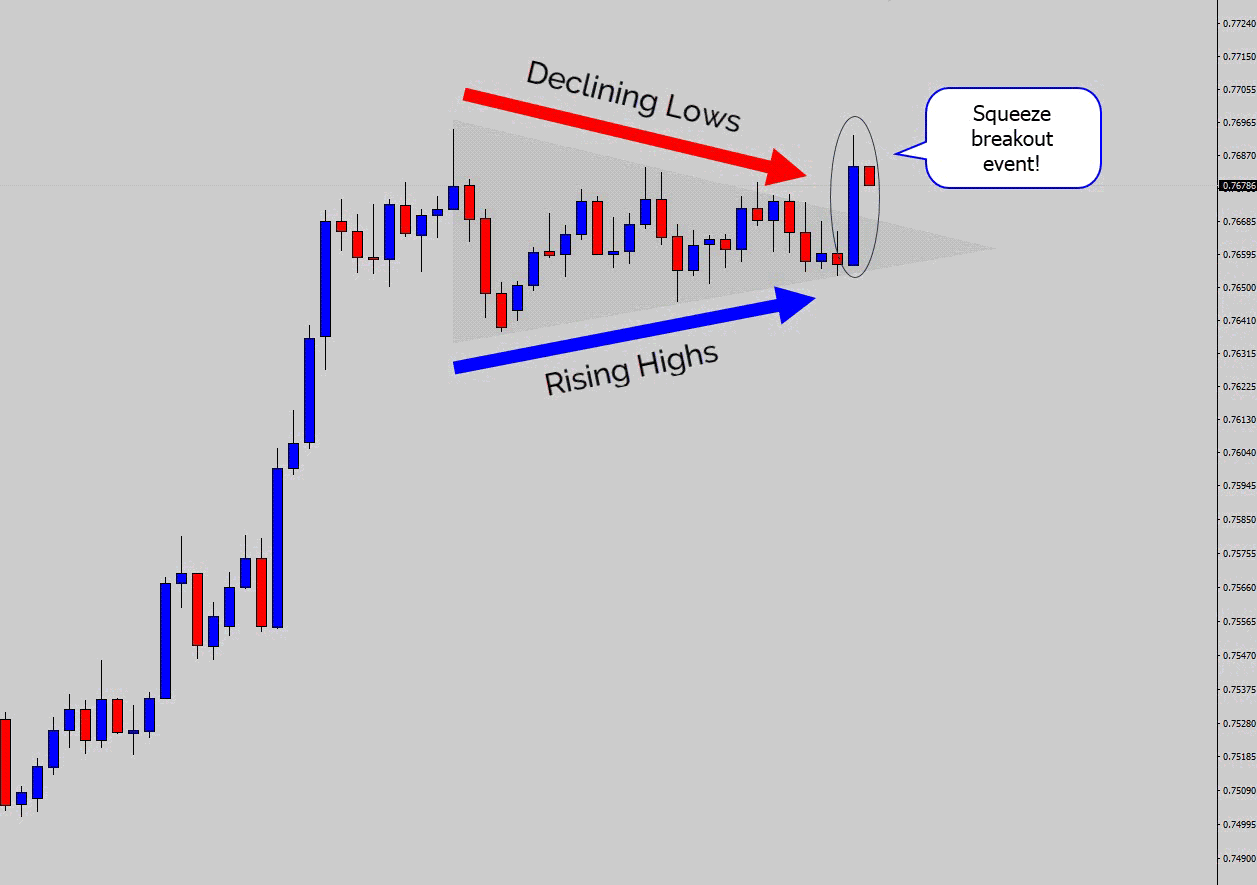
This squeezing kind of price action can happen anywhere, but I notice it more on the intra-day swing trading time frames (H4 – H12)
It signals the market is building pressure, and soon is likely to breakout violently in one direction. Look for the candle which clearly breaks the structure decisively.
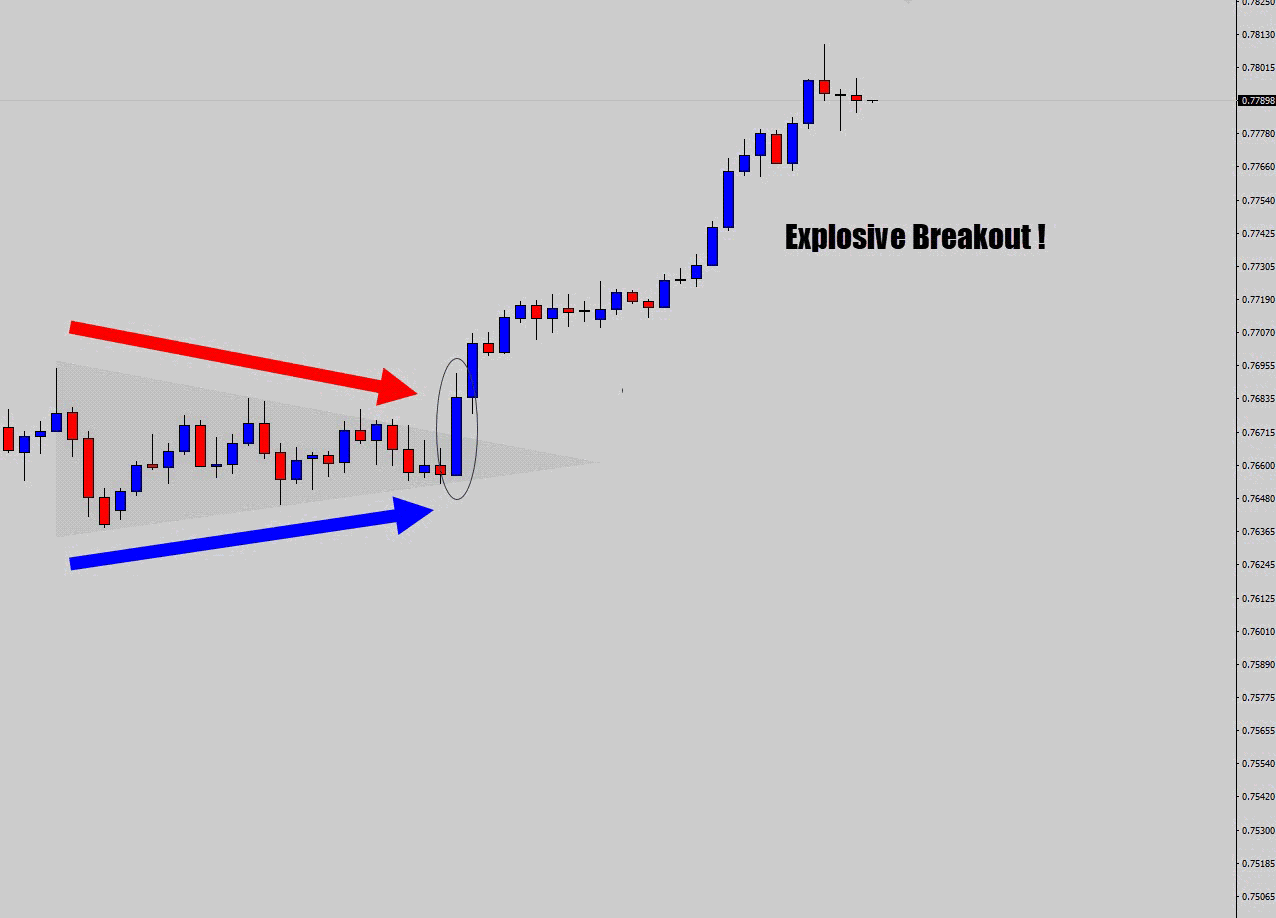
The idea is not to try and trade the bounces at the structure edges, but rather to wait for a clear breakout outside of the structure.
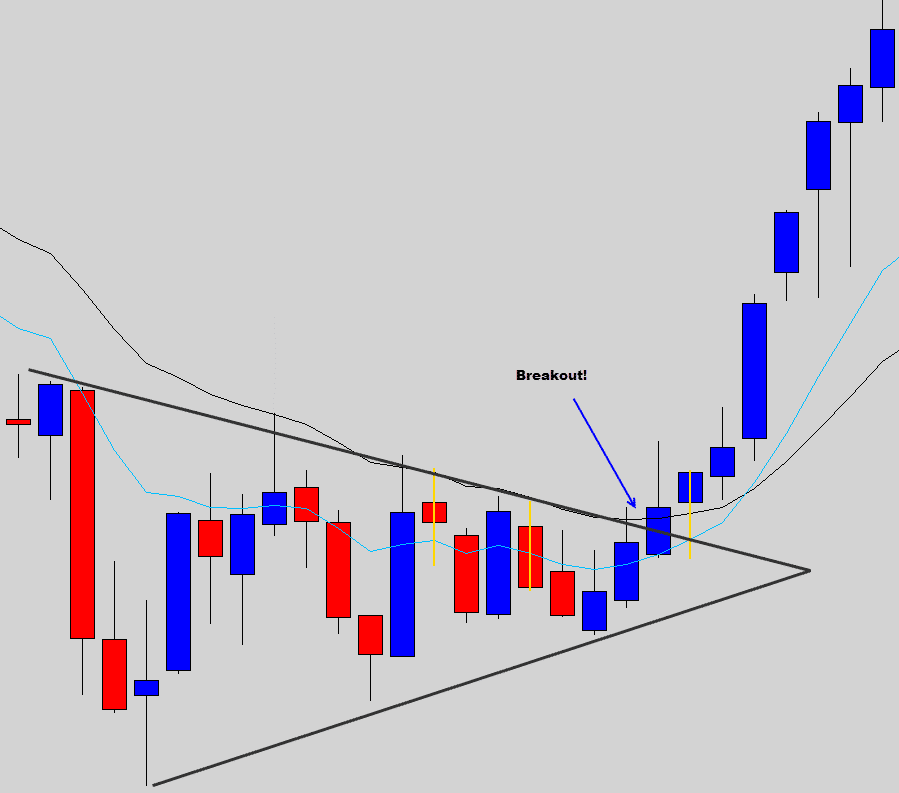
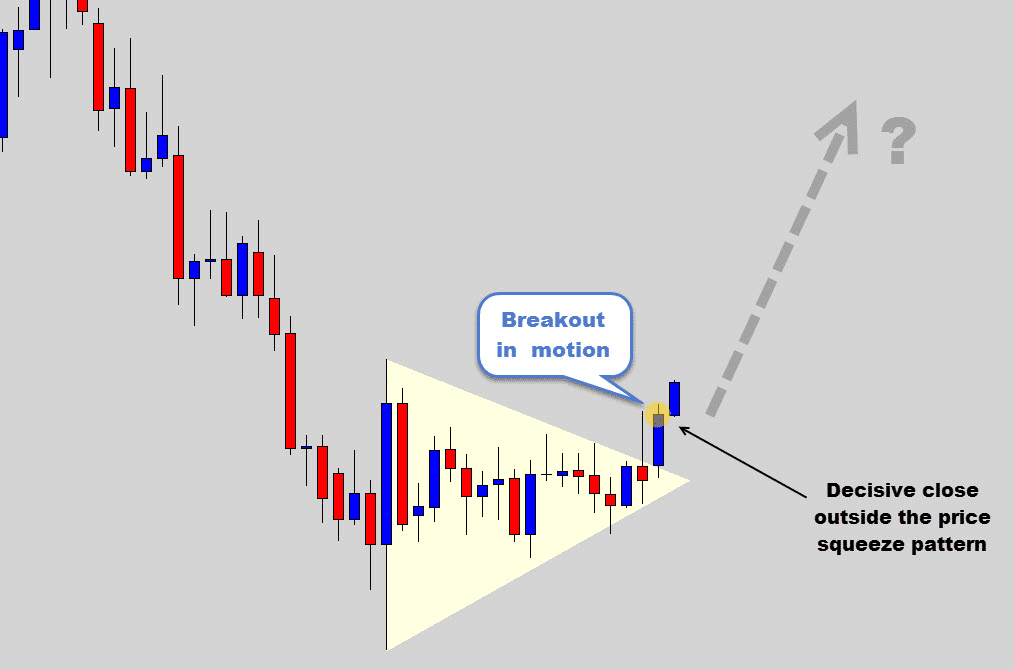
When you get a convincing close outside the squeeze structures, a decent move is likely follow because markets that breakout of consolidation periods are usually explosive.
You must be very cautious about being the aggressive trader, looking to trade breakouts ‘as they happen’, because these consolidation patterns are notorious for fake outs!
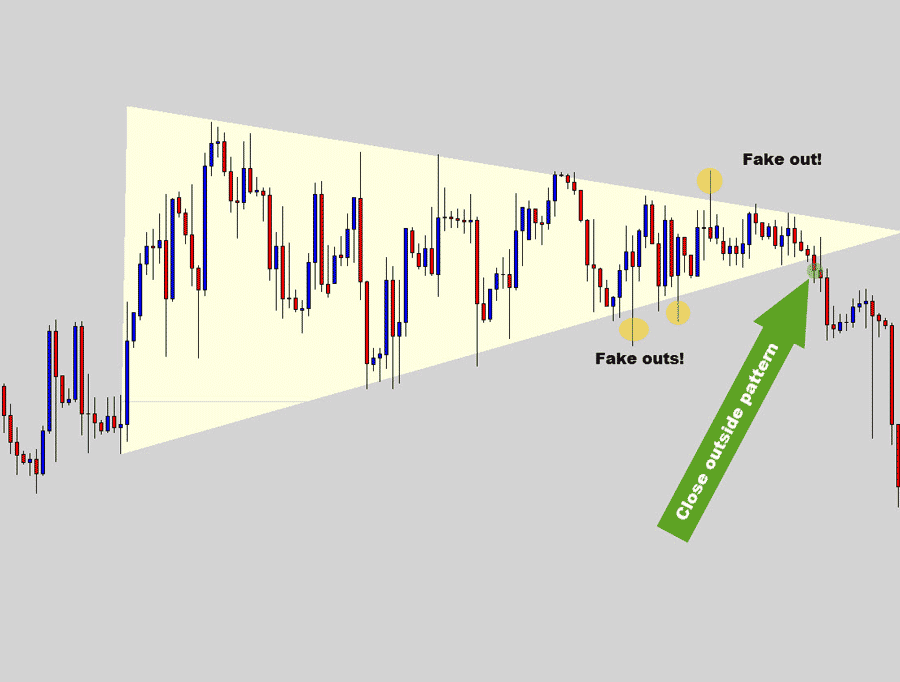
As you can see above, the aggressive breakout trader can easily get trapped when the market gives off the illusion that a breakout is occurring. Wait for the candle to close.
Getting caught in a fake out can be really frustrating. It may motivate you to negatively evaluate yourself, and kick off all kinds of self-destructive trading responses, like revenge trading.
It’s best not to trade these patterns in an aggressive manner, if you do choose to do so – just account for the extra risk of a fake out in your risk management plan.
Checkpoint
Fake Out Events – Capitalizing on Failed Breakouts
Ever gotten into a trade, only for it to reverse almost instantly?
It is easy to become really angry, even paranoid a higher power is out there screwing you over.
The truth is you probably got caught in a breakout trap, also known as a “fake out”.
The market is smart, it likes to play the technicals against us. The chart makes you believe the price is breaking out of a critical technical feature, you are drawn in believing “this is the breakout move”.
Just as you put your money down, the market ‘fakes out’ and reverses. Happens all the time.
That’s why it is best to avoid trading breakouts of very important levels unless you’re damn sure.
Next time take a different angle with it.
What if next time, you play it a bit smarter and sideline ourselves when the next breakout occurs. If the breakout holds, we play the patience card and wait for the next trade opportunity within the breakout momentum.
On the other hand, what if we see a fake out occur? Instead of being trapped in it this time, it could be used as trade signal!
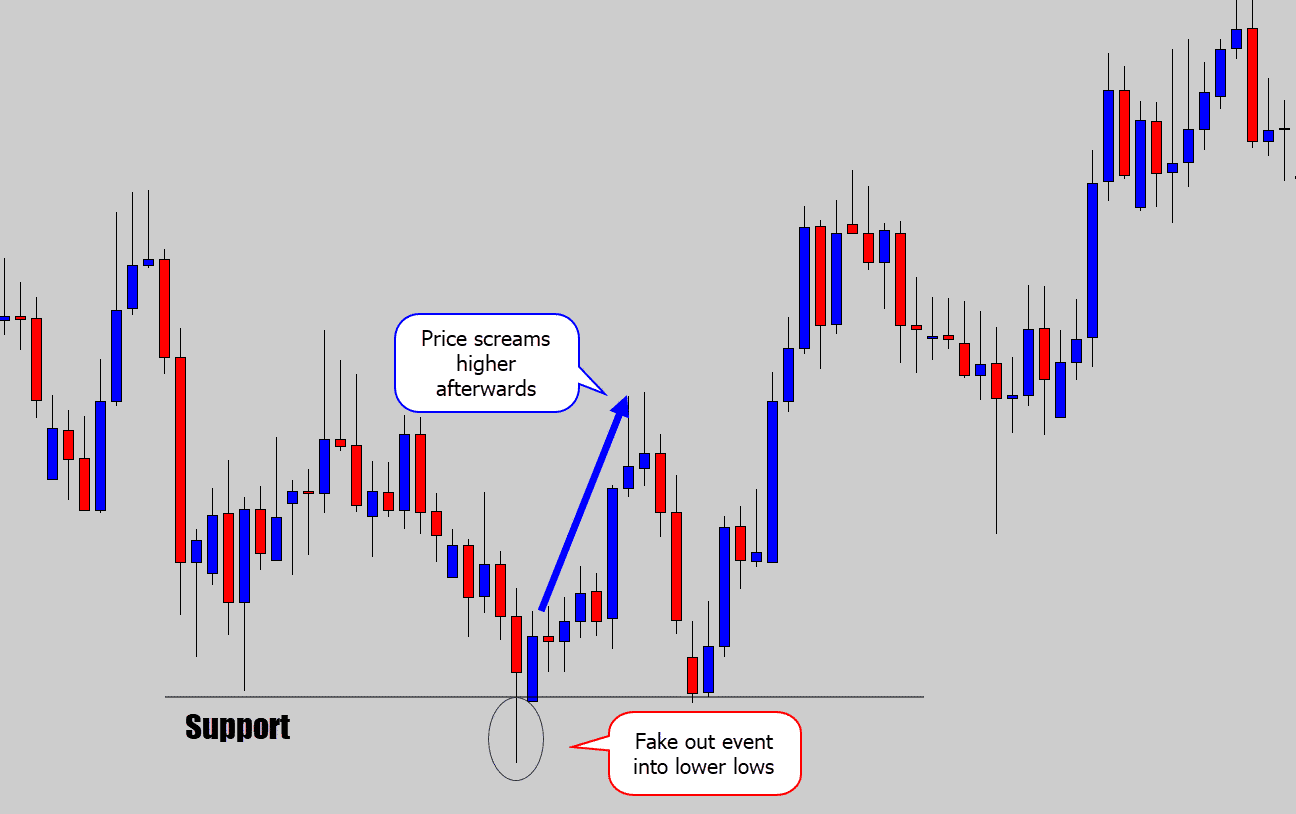
Above: The market clearly tried to break into lower lows here. If we were chasing breakouts, we would have been caught in a bearish trap!
But as a patient trader, we see the aftermath of the fake out as a large wick poking through the technical level.
This signals a failure to move lower and a lack of weakness / sign of strength in the market. Going long on this event would have yielded a nice pay day.
Another example, but this time a fake out to the high side.
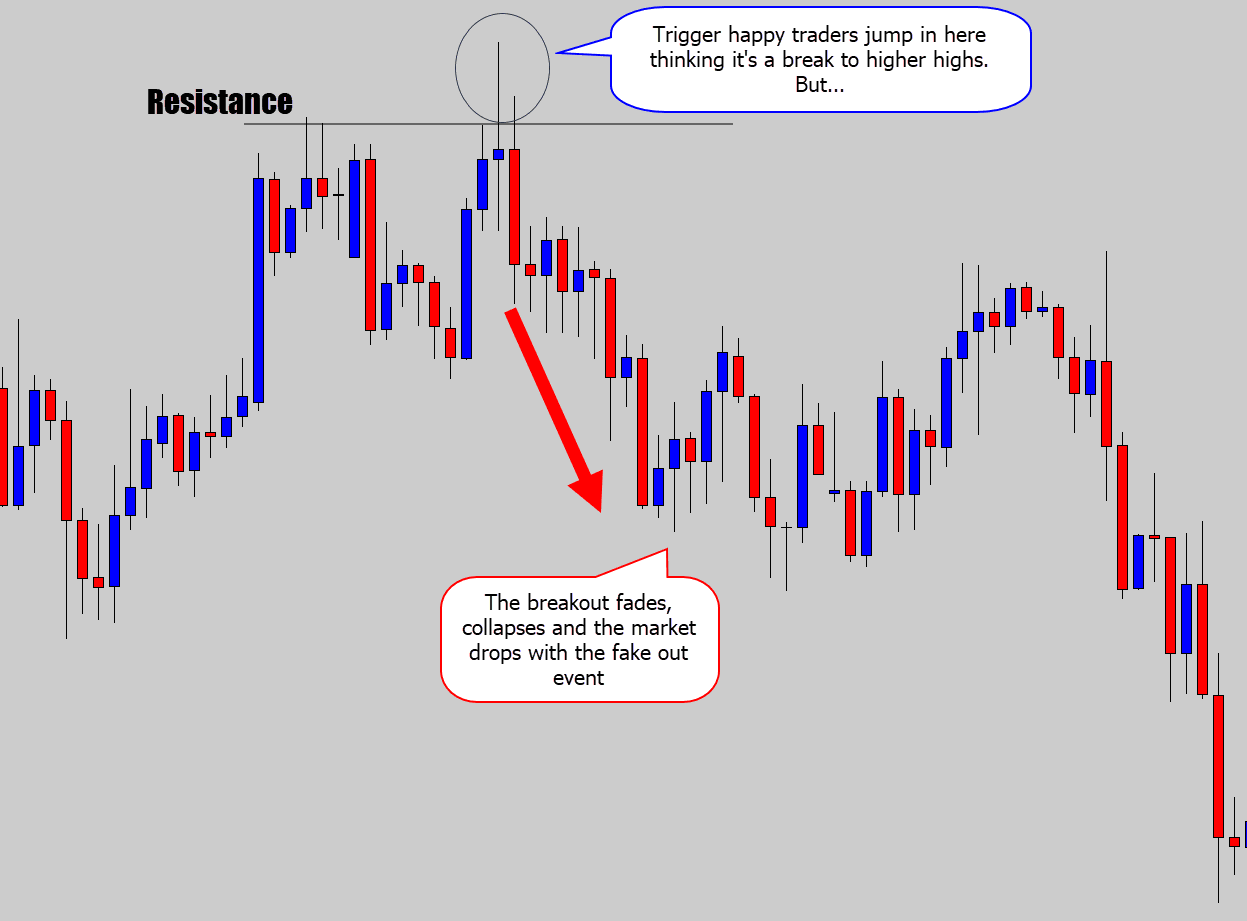
Above: Imagine you are the trader who tried to buy this breakout when it pushed through resistance, believing the next bullish move into higher highs was happening.
You would have been stomped out, annoyed, and probably thinking about taking revenge on the market.
But if we don’t try to trade breakouts of major technical levels, and wait on the sideline instead, the opportunity to capitalize on this fake out would have been printed on the chart.
The upper wick communicates weakness coming into the market after bulls are cleared up from the attempted push up. If we sold the market on this sign of weakness, the price action would have paid up.
I won’t make this tutorial too long by talking about this too much, it’s a simple concept and some “food for thought” for you to bring to your trading world.
Checkpoint
Price Action Trading Setups – Predicting Future Price Movement

A price action setup or “signal” is more than just waiting for your favorite candlestick to print, and throw money at it.
A signal should be multi step decision making process, bringing everything together to formulate a logical trade idea.
Think of it as a process of qualification – we analyse the environment first, identify hot spots we should be trading from, then wait for the signal.
Step 1: Do your technical analysis to identify valid market structure
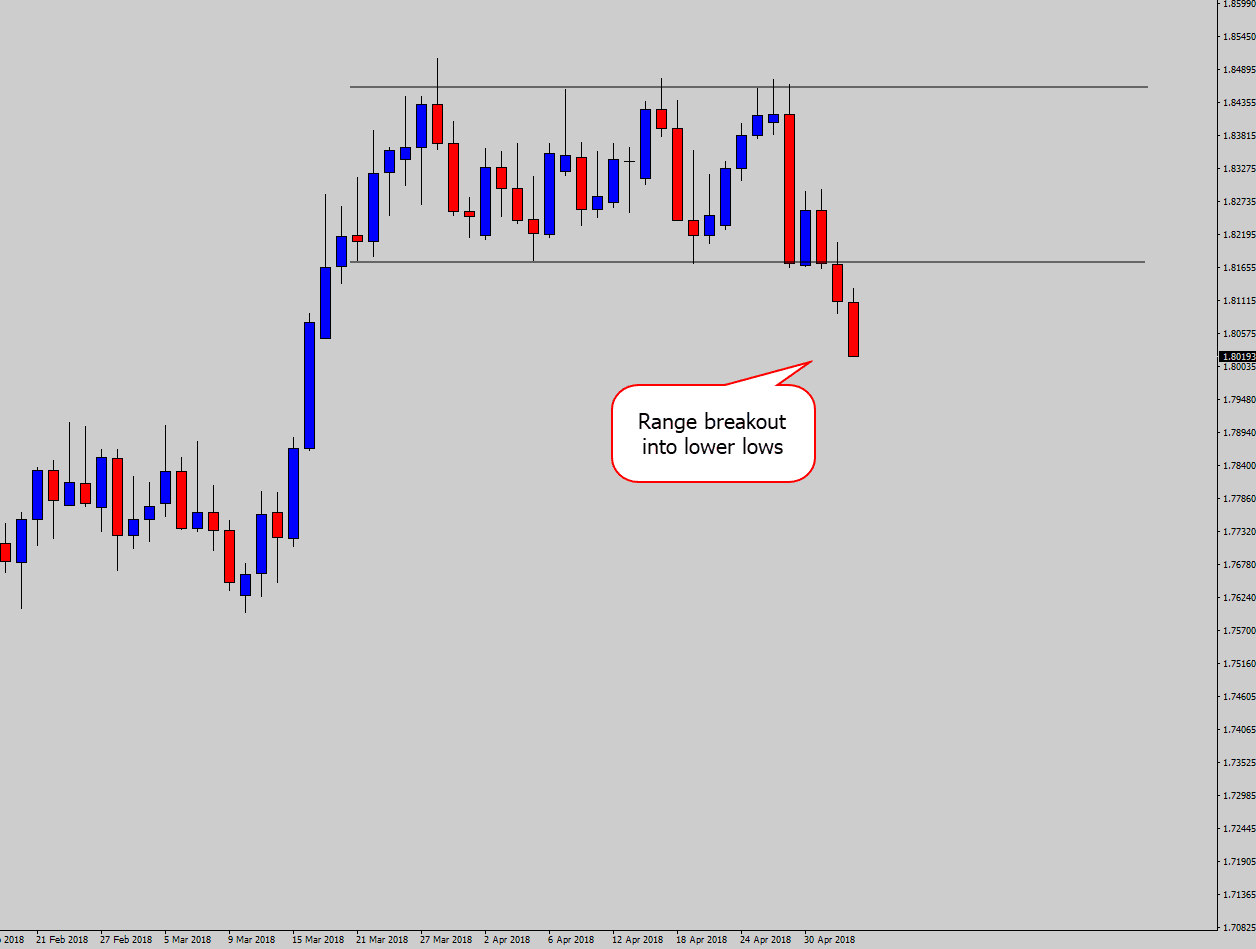
The first step is the most important. Do we even have tradeable conditions? If so what kind of market structure are we working with?
We can’t continue unless we have some context and reasonable structure to work with.
Here we have a ranging market which has recently broken to the down side, now we would ideally be looking for bearish signals to continue with the momentum.
Step 2: Target locations you expect a trade signal to occur
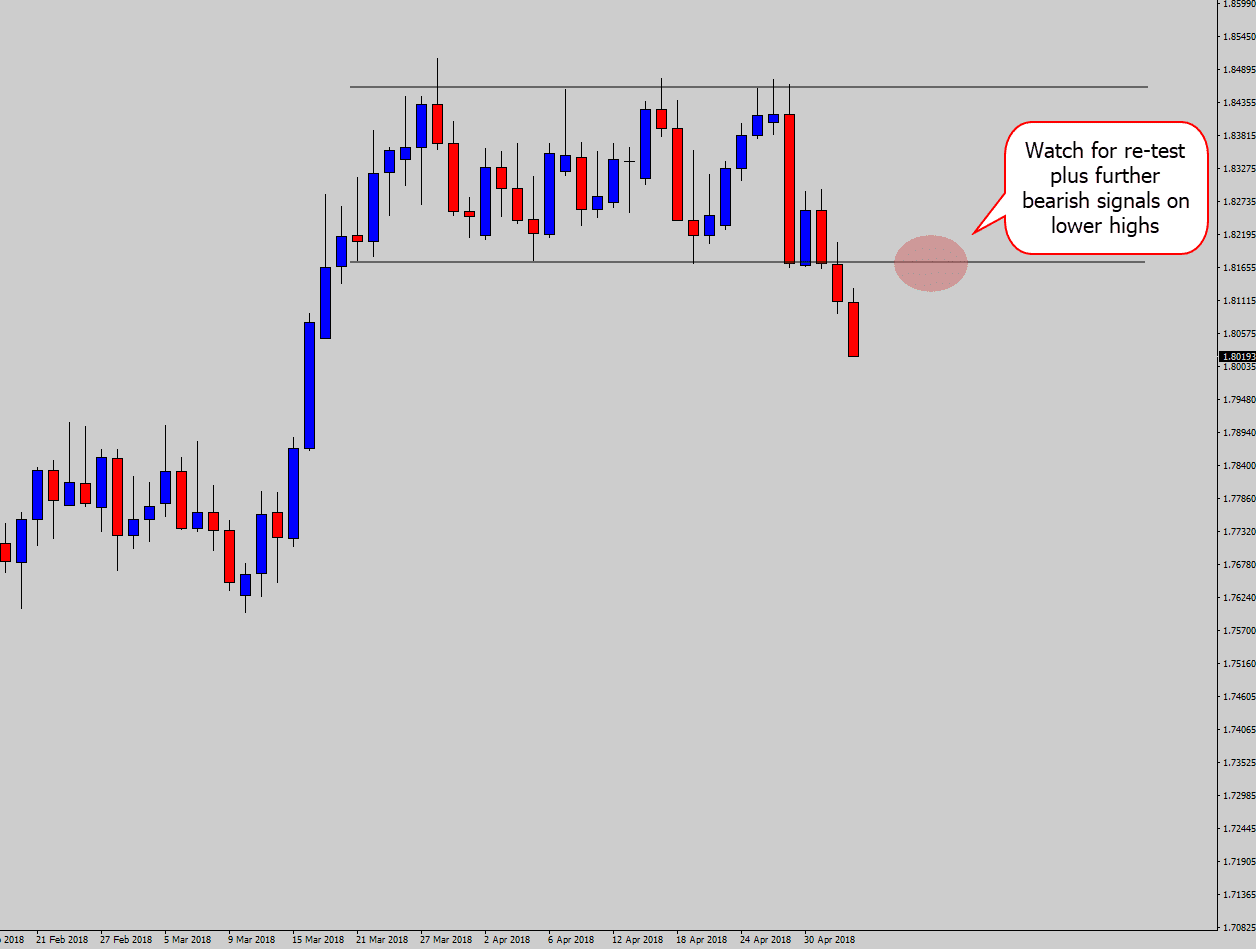
Once we establish our directional bias, we fall back to the technicals to highlight where a price action signal is likely to occur.
Step 3: Wait for the anticipated signal
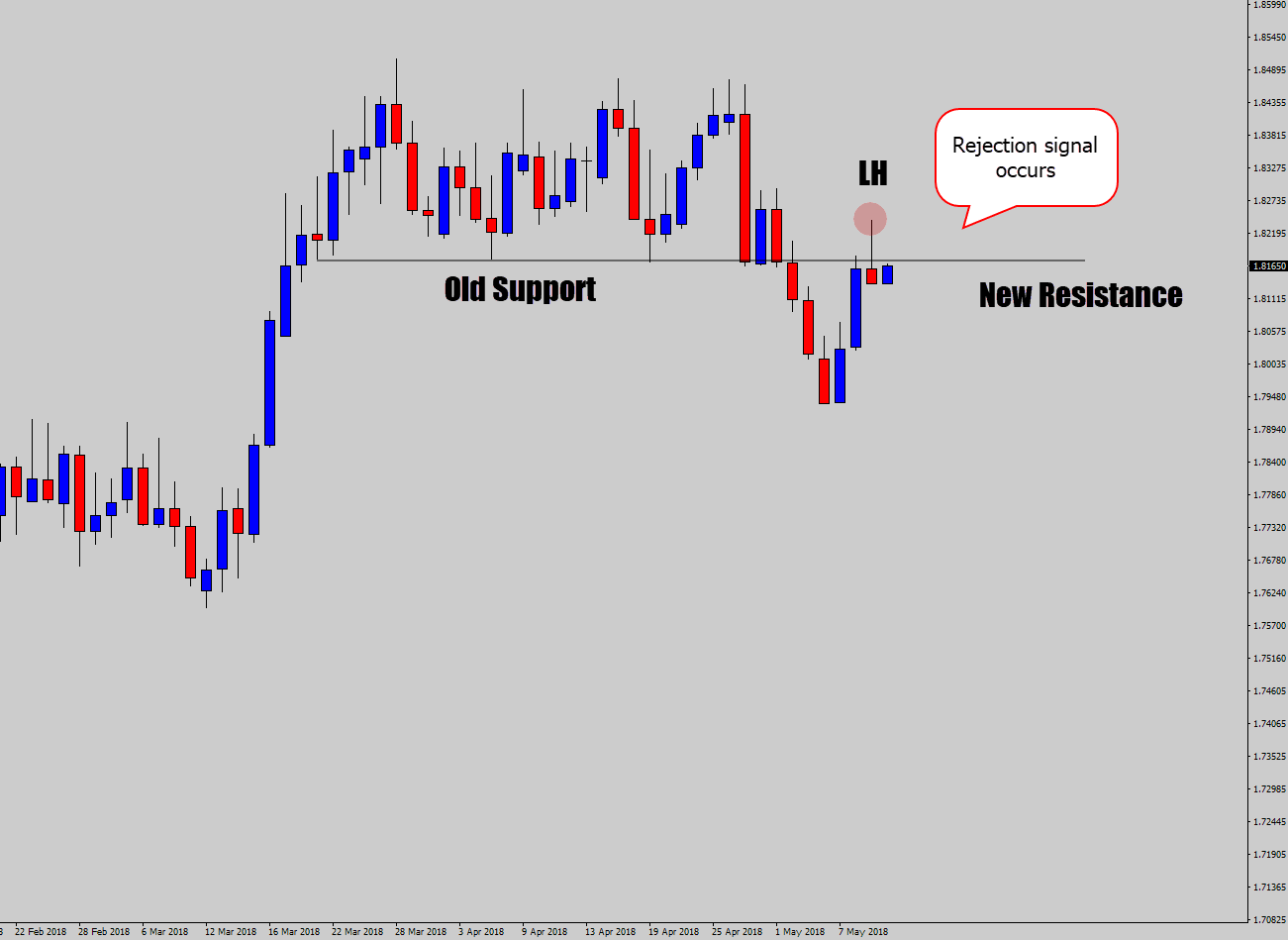
If a signal (like a candlestick signal) occurs in our predicted location (or very close to it), we have a very solid case for taking a trade.
Step 4: Check the trade has enough reward potential – Look for technical blockers to price movement
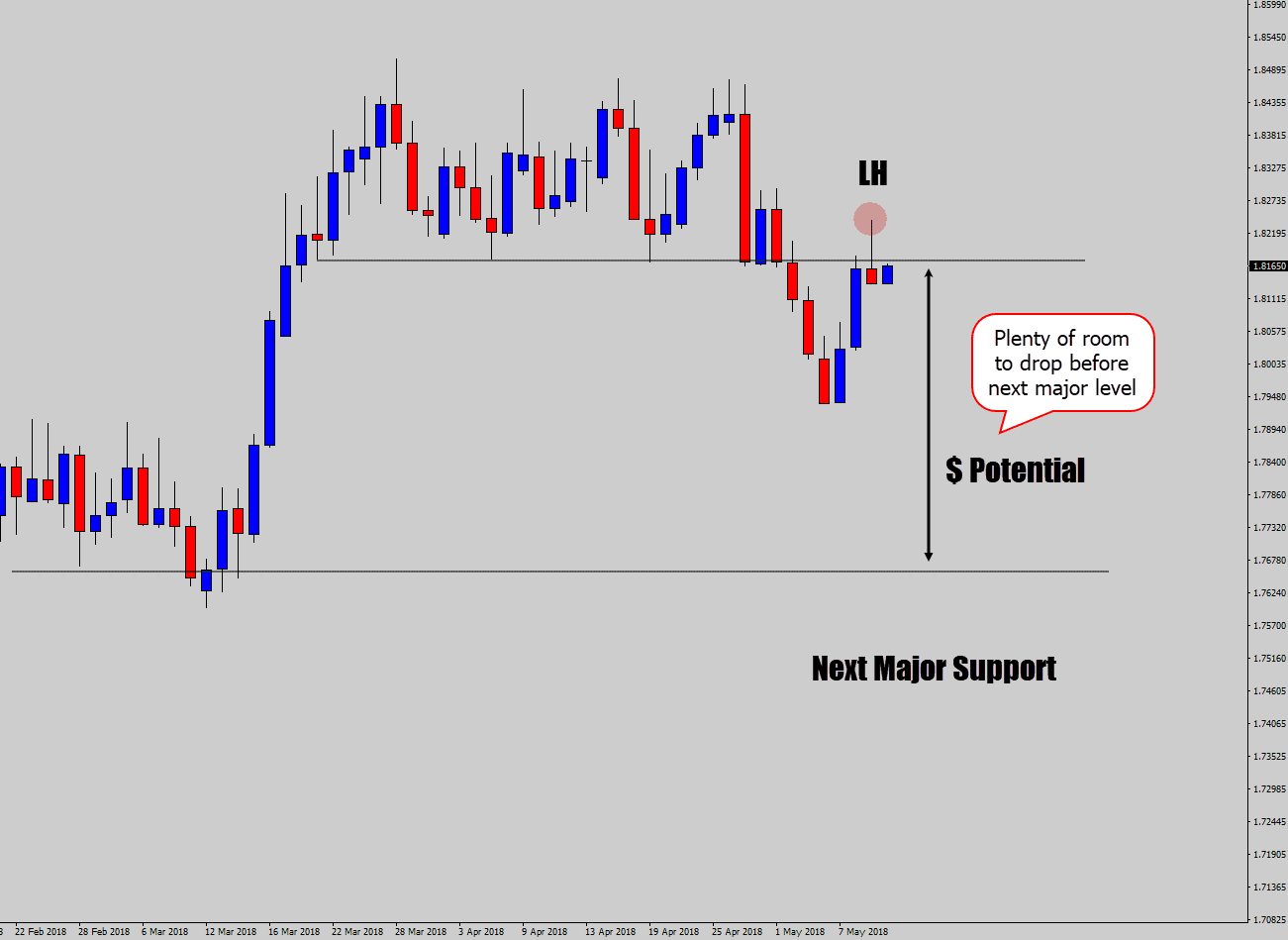
It is important to make sure the trade can output multiples more than you’re risking on it.
Make sure there is enough profit potential (the trade has enough room to move), before hitting the next structural level on the chart.
Step 5: Set, Forget, Collect – The stress free strategy for Forex traders
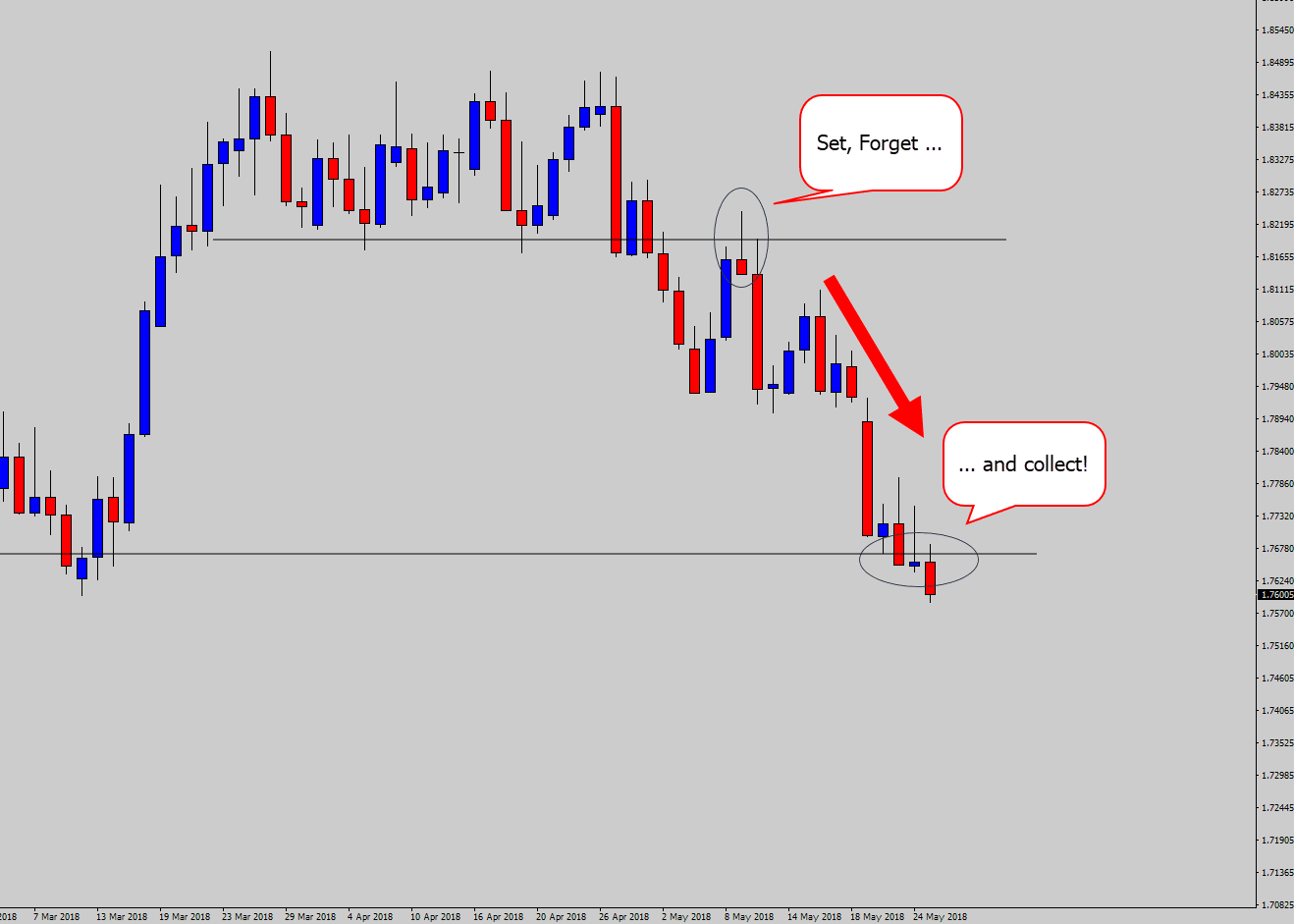
One you’ve measured up your trade, place your entry, stop and target.
The best way is to let the trade roll out and hit either your stop loss, or target price. The less human interference, the better!
This is how you filter out bad signals. When one step in the process fails, it’s probably a trade not worth taking.
It is when all factors align together, you get a high probability trade setup that you can have confidence in.
The value and the logic of the trade comes from:
- looking at the basics first
- keeping our thought process simple and logical
- working with the market structure
- being patient
Checkpoint
Exotic Charts Nobody Talks About
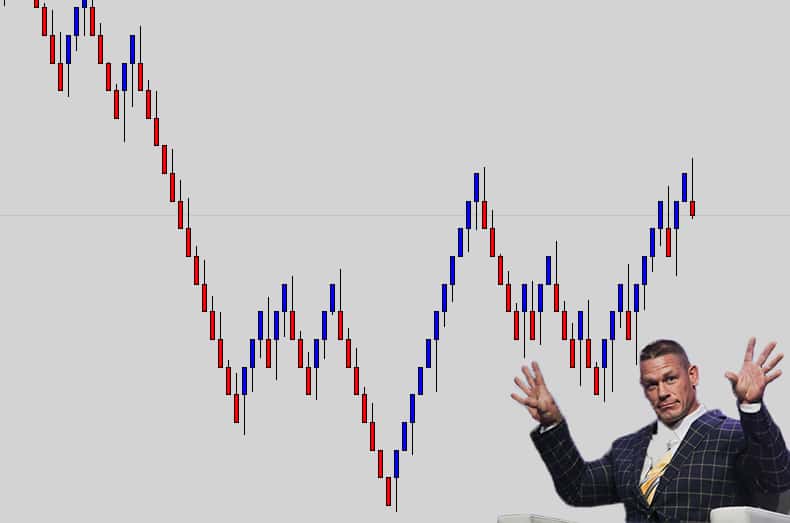
There are more charting formats out there than just classic candlestick charts (though that is what most people are familiar with), and can be used by price action traders to get different perspectives on the market.
These other price action mediums actually allow you to see opportunities that normally would have eluded you with traditional candlestick charts.
This is an area I am researching heavily at the moment, but the preliminary findings look promising.
So, lets looks at the classic candlestick charts and some compare them against some of the other formats available.
Customized Candlestick Charts Showing Unique Price Movement
Most traders believe New York close charts are the only charts you should be looking at. But the reality is, New York close charts only provide a reference point to base your analysis on.
I am not saying New York close charts are bad, they are excellent and I use them every day. But, have you considered using the London open time as a reference point for your cross analysis?
Let’s compare a New York close chart and a London Open chart…
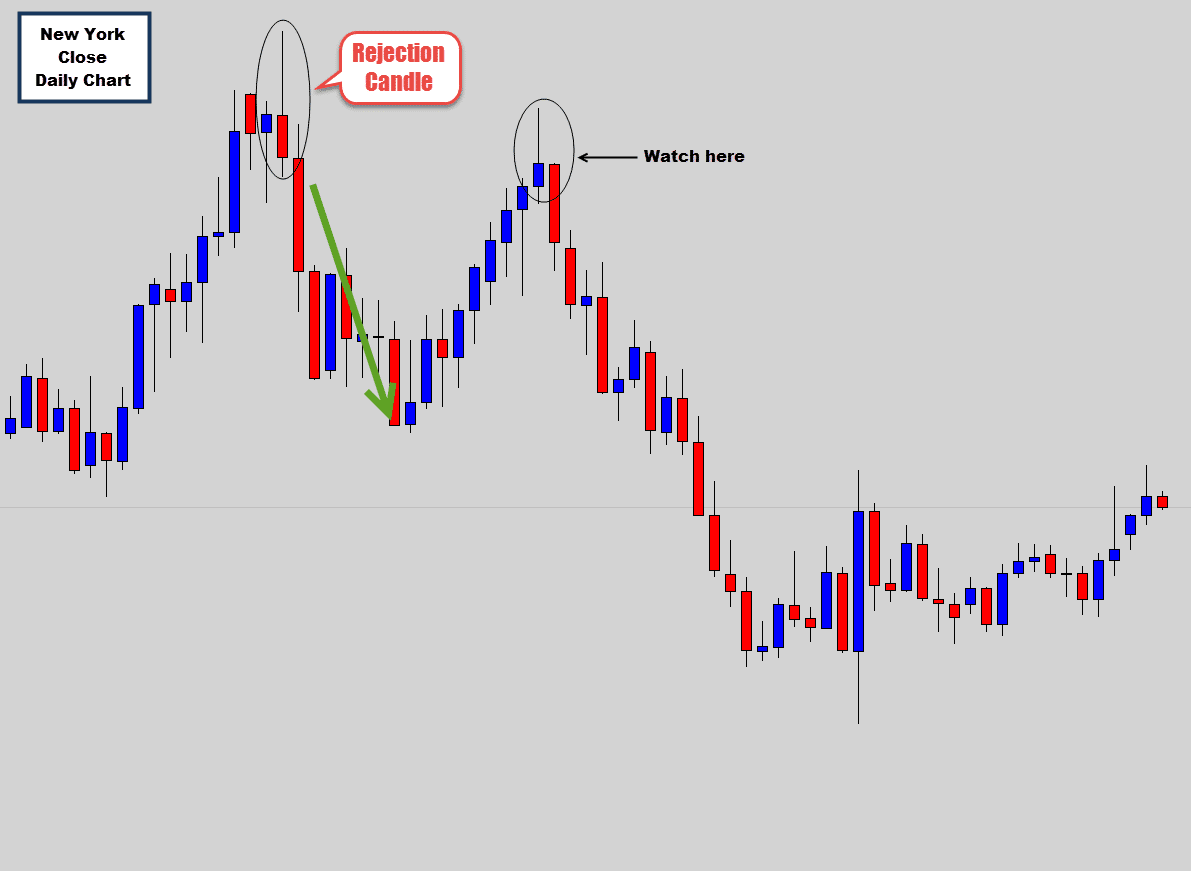
With the London open charts, we are able to see a strong sell signal that was otherwise not as obvious on the New York Close chart.
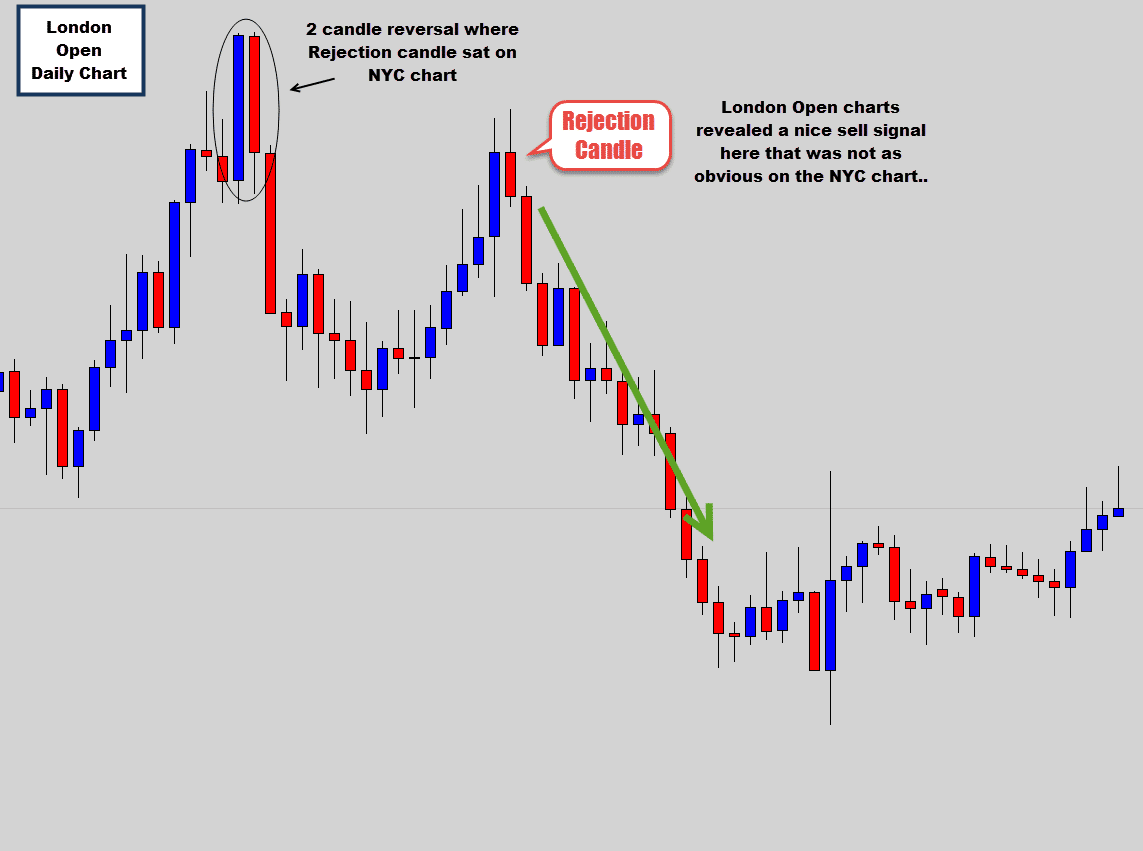
But this is no reason to discount NYC charts either, as we can see a nice big sell signal there which was not as obvious on the London Open chart.
Here is a New York Open chart thrown in for good measure…
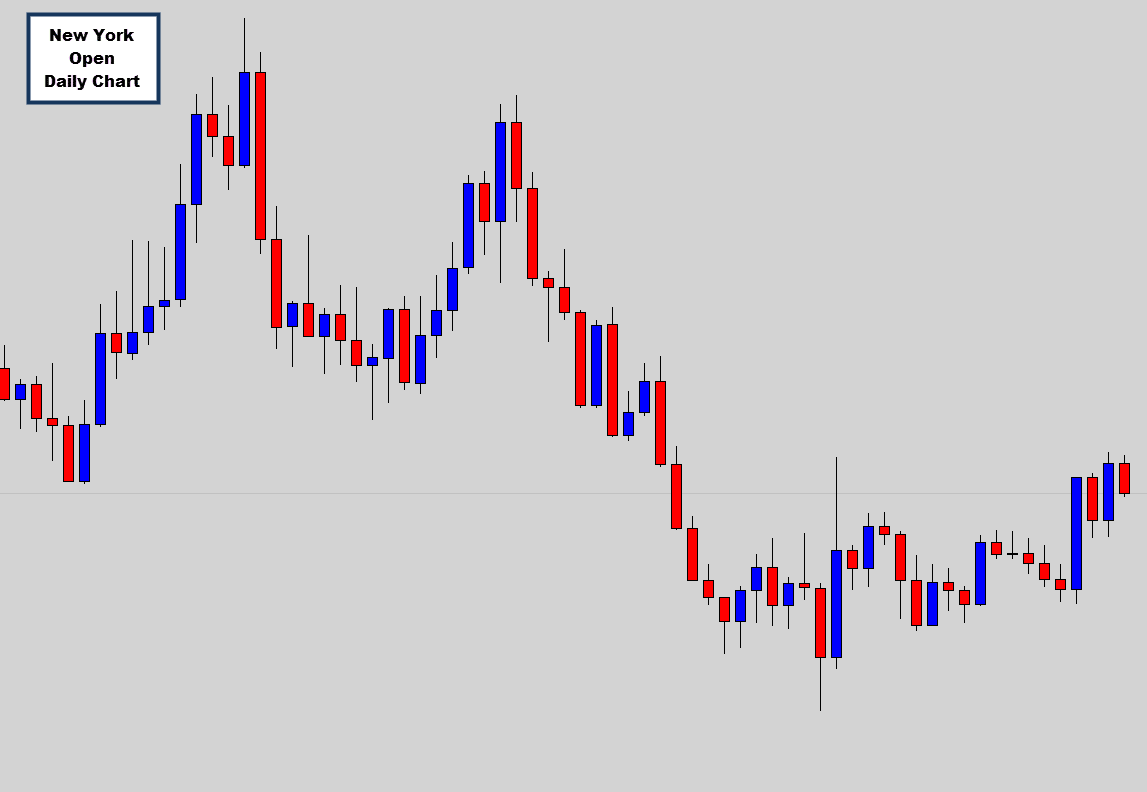
There isn’t anything obvious screaming out here, but this is just to show now with this one pair, we can have 3 different time perspectives which dramatically changes the chart.
This is “panning for gold” approach where you sift through different time perspectives and look for the price action “gold nuggets” nobody else knows about.
You could really shift the charts 23 different ways, as you could generate a chart with every single GMT hour, but I think it’s important to keep things simple and stick to the ‘main event’ times like New York close, London open and the New York open as a starting point.
This really opens up the door to some unique analysis for price action traders!
My custom chart builder can make this happen, more on that further on.
Checkpoint
Renko Charts – A Whole New World of Price Action!
Have you ever seen a renko chart?
They look absolutely beautiful – just one glance at you will be enchanted by their beautiful structure.
If you want to know more about how they work, see my renko charts explained tutorial.
To summarize: they are the result of removing time out of the equation – candlesticks that are price movement based, not time based.
Here is the same chart as the previous two above, but in renko format…
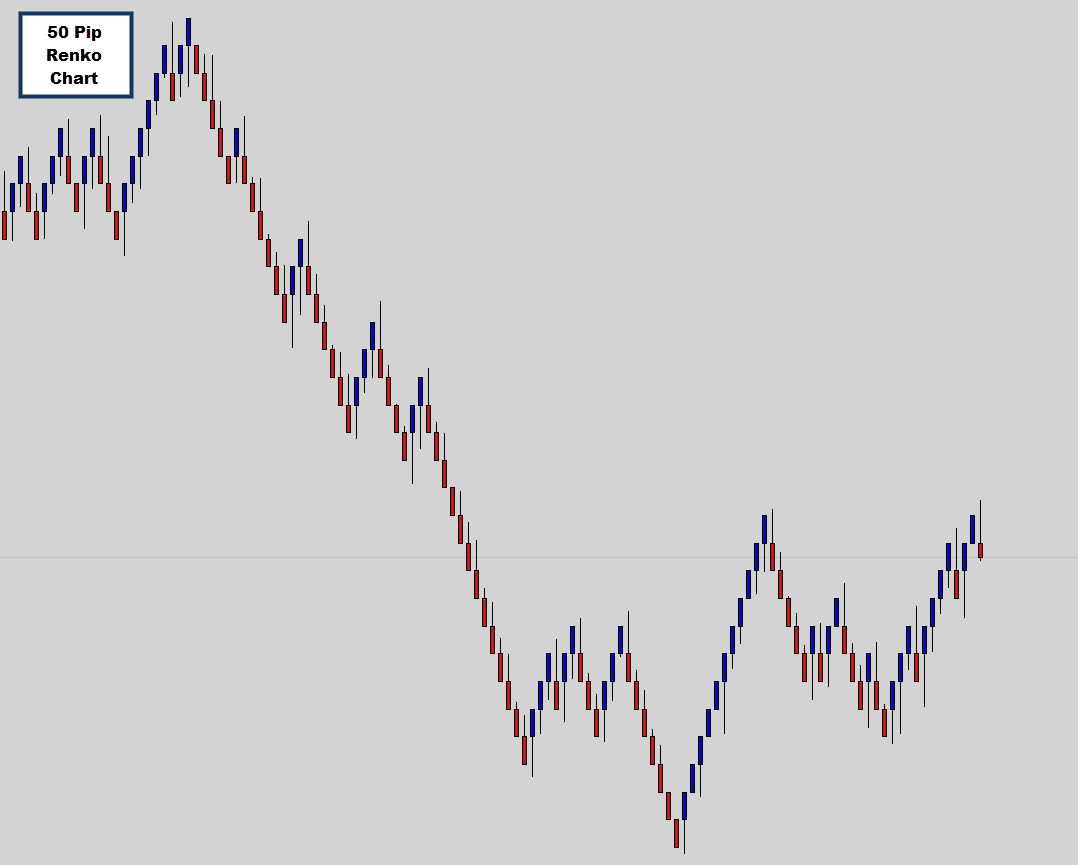
This is a 50 pip Renko chart, meaning the body of each Renko candle is exactly 50 pips – no more no less.
Every time the market moves 50 pips, a new candle (sometimes called brick) will form, regardless of how long the market takes to do so.
It could take 5 mins, 5 hours, or 5 days to create a new Renko candle, it’s purely a momentum based trigger.
Renko charts are great in the way they help eliminate noise, and really let you peer into the core movements of the market.
During strong trends, Renko charts paint a pretty clear picture…
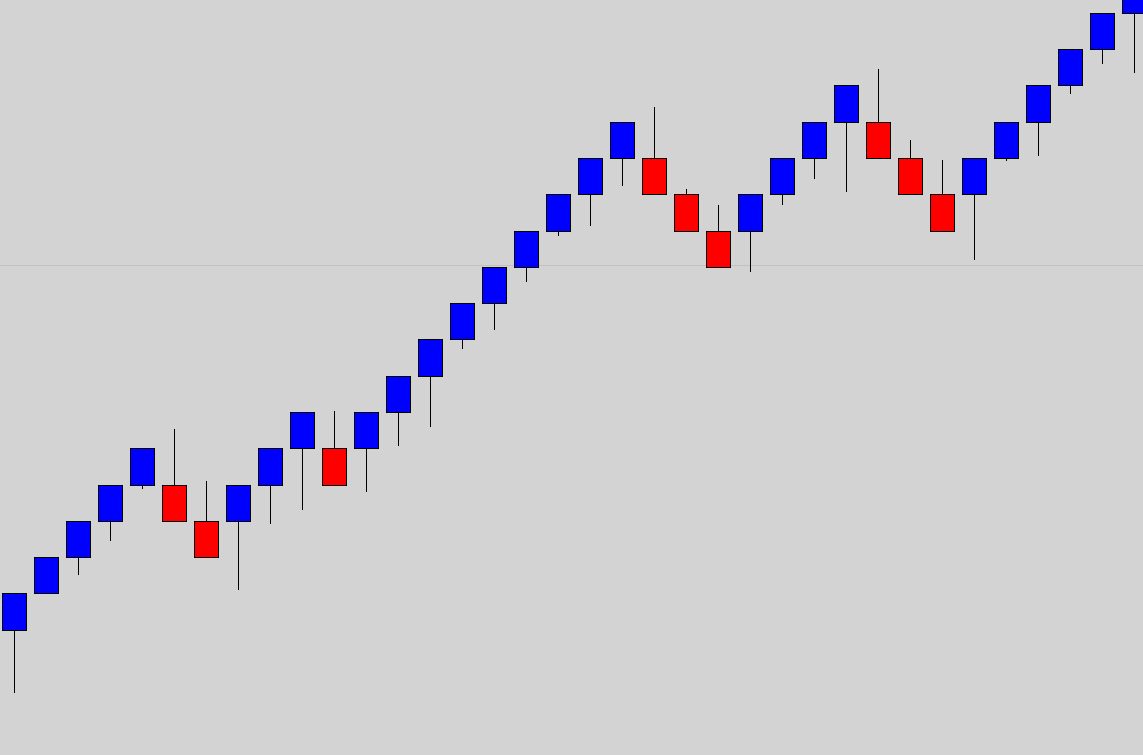
It just paints a really clear picture to what’s going on with the market and can make chart analysis very pleasant. Tasks like finding market structure, and locating important support and resistance levels start to become very easy with renko.
Obviously, you have the freedom to alter the renko chart size to whatever you like, you could have 10, 25, 200 pip Renko charts.
The same principle applies as candlestick charts, if you start going into very low numbers – then the renko chart can become too noisy and lose its analytical value.
Checkpoint
Heiken Ashi Charts – Averaged Movement to Reduce Noise
This is a chart format that is talked about only in smaller circles, but I’ve known about them for many years.
The easiest way for me to describe a Heiken Ashi chart is the result of applying ‘averaging’ math to a candlestick.
A new candle is created based off of averaging formulas applied to the previous candle. So in laymen’s terms, a Heiken Ashi candle is a unique ‘averaged’ perspective of the previous candle.
The end result is this ‘chained average effect’, helping ‘smooth out’ the chart noise. These charts are attractive because they filter short term vibrations in the market.
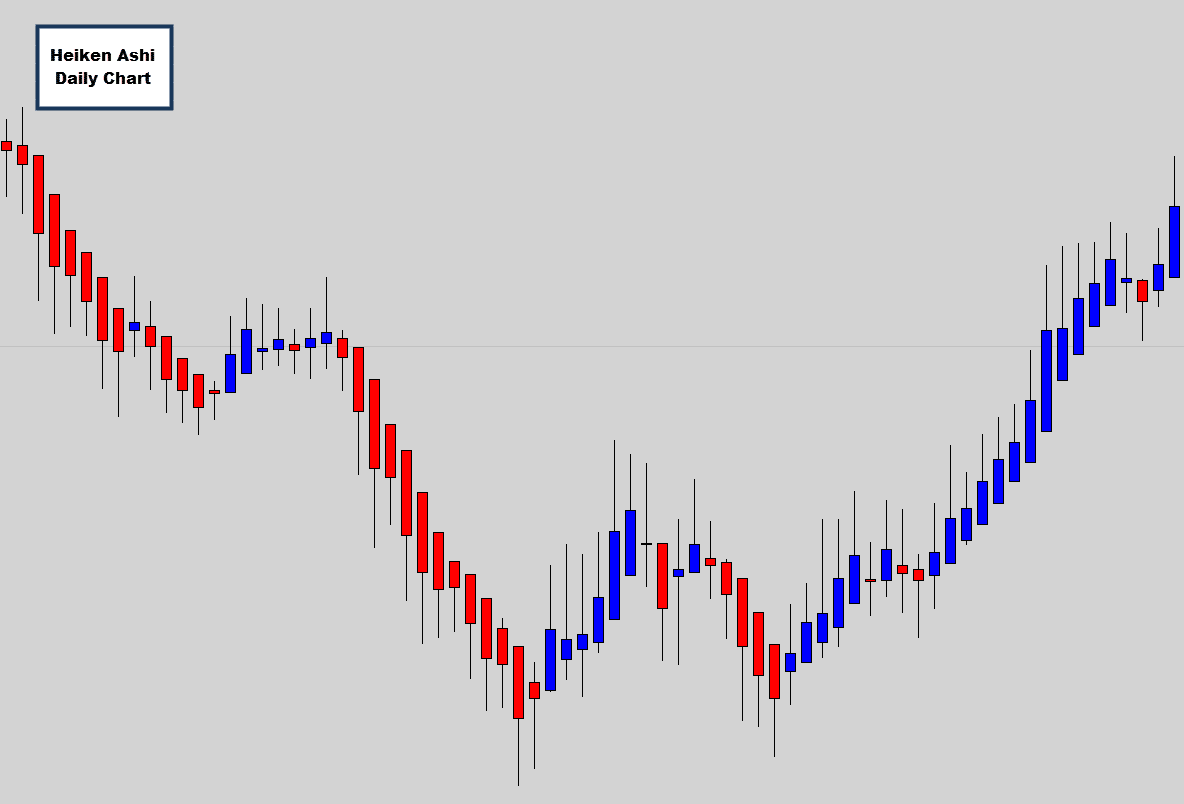
The Heiken Ashi average math does make the candles look unconventional. To understand what these charts are trying to communicate, the trick is to compare the body size to the wick.
If the body size is large, and the wick is small – this indicates strength in the price movement. If the body is bullish, then you’ve got strong bullish pressure, and a bearish body indicates strong bearish pressure.
If the body is small, and the wick is large – this can indicate the opposing side is ‘putting up a fight’ and momentum is slowing down. As a trend comes to an end, you will generally see the bodies get smaller and the wicks get larger.
If you see Heiken Ashi candles with wicks protruding out both ends of the body – this communicates indecision. Here is the same chart example from the candlestick and Renko sections above, put into Heiken Ashi format…
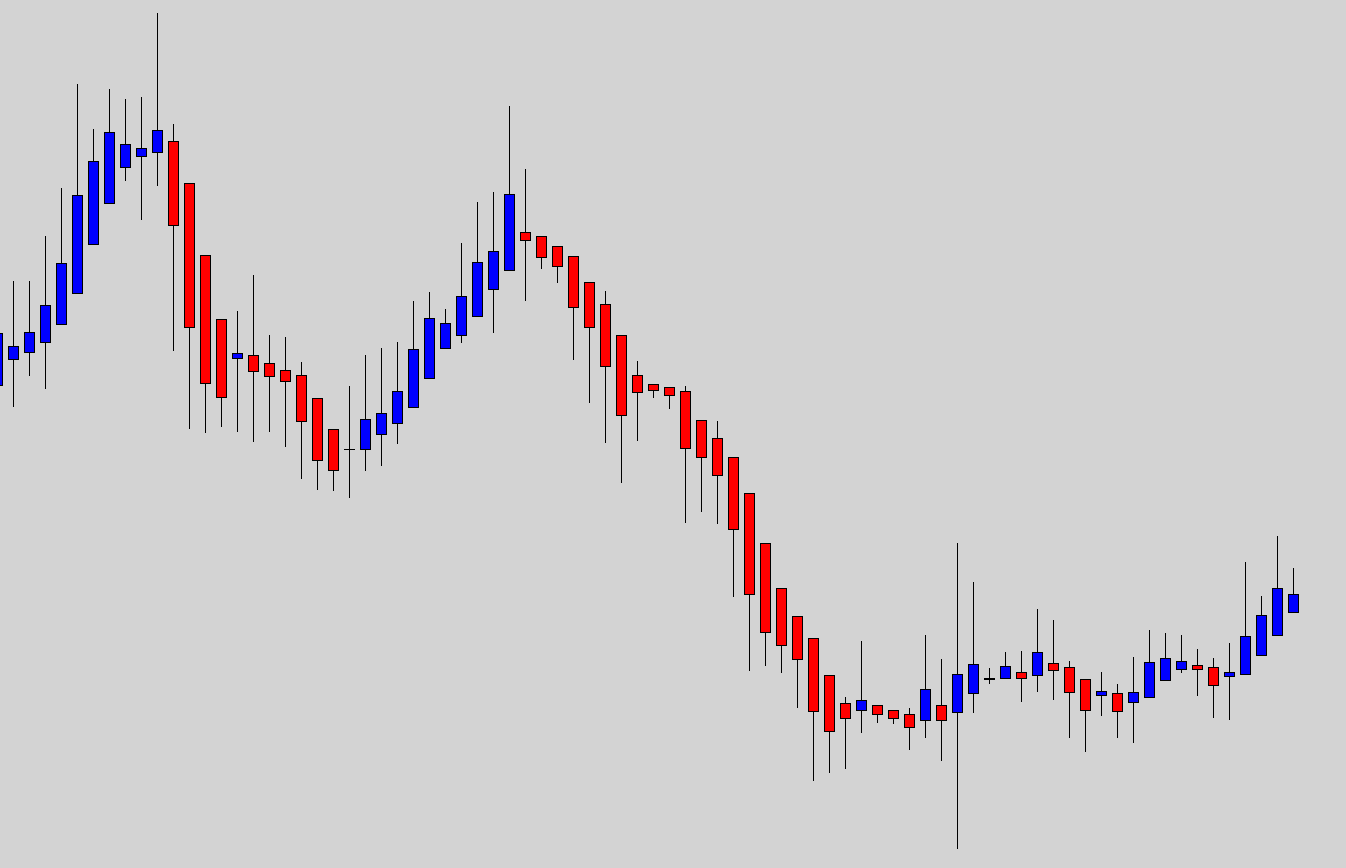
If you would like to learn more about Heiken Ashi charts – check out my Heiken Ashi charts explained tutorial.
Checkpoint
Tools For Price action Traders
What “tools of the trade” do you need for price action trading?
Answer: You don’t need any.
However there are needs, and then there are wants 🙂
I use some tools to aid in my day to day trading for sure. The catch is all the tools I use, I made myself.
A tool’s function is to help you solve a problem. I will give you a quick overview what problems my tools have solved for me and other traders…
A Candlestick Pattern Scanner & Alert Tool
I watch 30+ markets, and now with some cyrptocurrency markets being added to my broker – the list keeps growing.
To make matters more extreme, using MT5 – which has more swing trading time frames that I like to monitor & trade (4, 6, 8, 12 hour).
8 hour is my favorite!
Plus I already watch the daily chart too. So that’s 30 x 5 different time frames = 180 different charts.
I can’t be in 180 places at once!
That’s why I created my Battle Station chart scanner tool.
It monitors each chart you attach it to, plus all the other swing trading time frames I listed. It will send you alerts (to your iPhone or Android) when it finds a candlestick pattern or detects a breakout event.
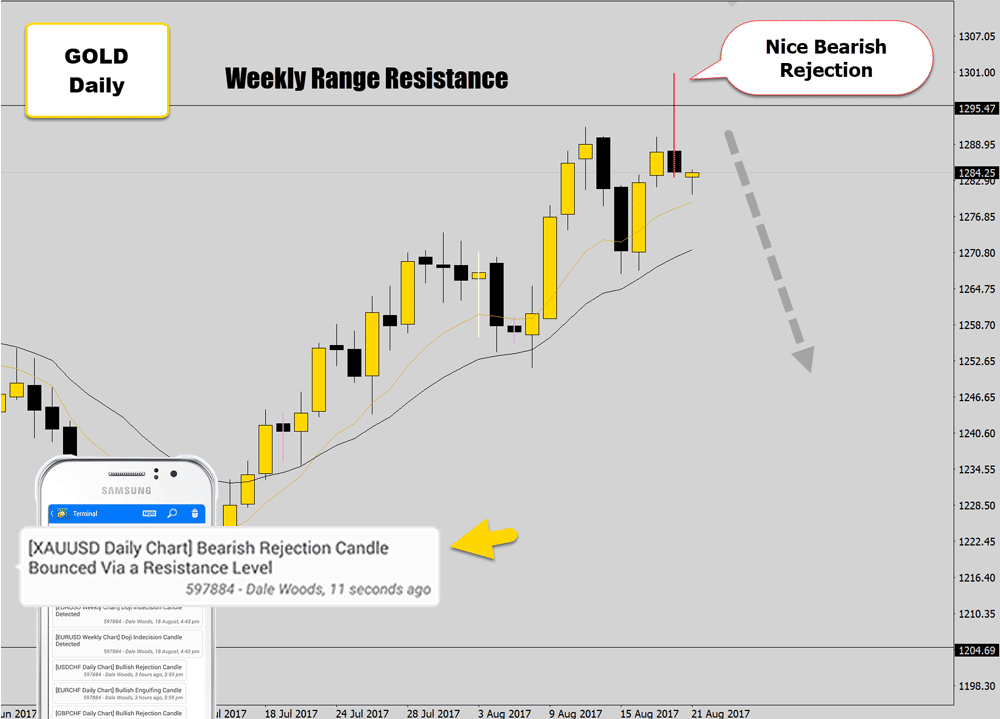
The Battle Station saves me a lot of time, and gives me the charts and time frames I should be looking at when something happens in the market.
Trade Panel (Lot Size Calculator, Trailing Stops, Multi-Order Trades)
When you want to place an order, there are a few ‘on the spot’ calculations you need to do. Depending on how complicated you want get with your order, you may really need some tools to save you some of that number crunching.
That’s why my trade management panel was born – to make trade placement simple and easy, and give us the extra options metatrader 4/5 don’t provide…
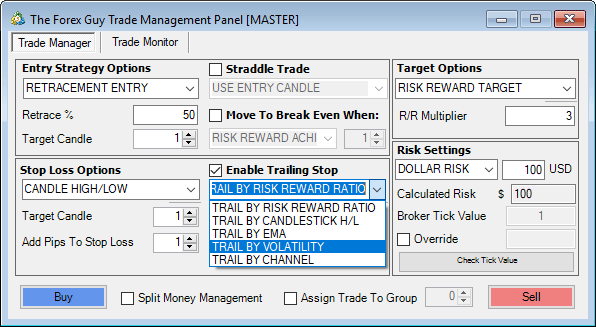
On a a basic level, the tool helps with converting a dollar risk figure, to a precisely calculated lot size (based off your entry and stop loss).
This is what the trade panel is most loved for, because most traders don’t want to grind through math every time they place a trade.
The trade panel has more advanced functions like: a variety of different trailing stops, OCO orders, move to break even conditions etc. It is a Swiss army knife that traders love to have in their pockets.
Custom Chart Builder – Make Your Own Price Action!
This tool has been one of the more difficult tools to bring to life, and not as necessary of a tool – but it will give you access to some exotic price action that the trader next to you has probably never seen before (which we talked about briefly above).
There are some tools out there being shared around on forums which can build custom charts. But they are usually are only a “one trick pony” kind of tool. My chart builder is very dynamic with what it can output.
That’s why I made it, to solve all the annoying problems with custom charts.
My chart builder allows you create all the charts discussed previously above, in as many different ways, and spin as many different charts as you like…
All this rich functionality is managed from the one panel.
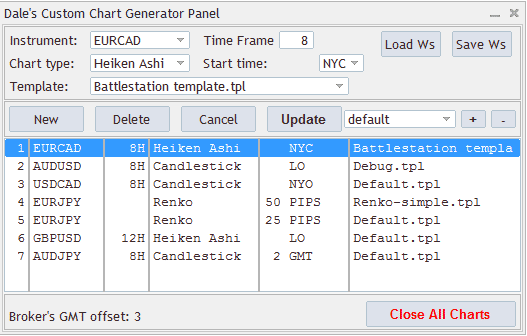
You can see with the chart builder panel, I have a lot of control with the kinds of charts I can create. In this setup I’ve created
- 8h EURCAD New York Close Heiken Ashi chart
- 8h AUDUSD London Open candlestick chart
- 8h USDCAD New York Open candlestick chart
- 50 pip EURJPY Renko Chart
- 25 pip EURJPY Renko Chart
- 12h GBPUSD Heiken Ashi London open chart
- 8H AUDJPY candlestick chart applied to +2 GMT
If you’re more of an advanced price action trader, or you love to get your head buried in data – this tool is probably going to be right up your alley.
Sorry to flash all my goods to you, and leave you wondering where to get them.
Originally all my tools were made as part of my trader’s group – but due to high demand, I did release a trial pack so you can try them out right now!
You will see the download box for the tools at the bottom of the article 🙂
Price Action Trading Course

I hope this guide really helped you understand what trading a price action strategy is all about and gives you actionable knowledge for you to take back to your charts.
If you made it this far, I can only assume this is a topic that you’re very passionate about and hungry to learn more secrets.
Although this guide has been very long, I still was only able to skim the surface of price action trading knowledge.
If you’re really serious and want to learn more – I have created my Price Action Protocol price action trading course which is a very in depth guide, and shares the rest of my price action secrets.
The course is part of my War Room for traders. If you’re interested in learning more about that, you’re welcome to check out the War Room information and sign up page.
Otherwise I hope you’re able to take what you’ve learned here, and apply it to your trading with a positive results.
I wish you the best with your price action trading – until the next tutorial, best of luck on the charts.

ditter
Thanks you a lot, creating this helpful article this mean to me sir.
Replying to: ditter
Dale WoodsAuthor
you’re welcome 🙂
Agaphe Susilo
Simple and straight to the point
I’ve blown my $2k x 2, and now im profitable after i found your blog
Thanks dale, you are the man
Dale WoodsAuthor
You got it backwards. Trading on the lower time frames is difficult. Trading the higher time frame is easier, people just don’t have the patience for it.
Replying to: Dale Woods
Addmen
Hi dale, i have a question..do you watch/wait for the upcoming market news to correlate with your trade or do you just stick to the price action trading only and ignore the upcoming news..for example, when there is a bearish rejection on weekly level on eurusd pair but at the same time there is an upcoming NFP news, do you still take the trade or you wait for the news result first??
Venkat
Its very very helped me👍, thanks for giving
Lizz Vargas
Very informative and easy to articulate, thank you 😊
Jimmy Zonda
Hie Dale,
Thanks for the free priceless knowledge on the website. Please get back to posting on YouTube,, Notification is already on waiting for your amazing videos.
Haryh
Merci infiniment, tu as amélioré mon trading de manière inimaginable !
Lisa McCartney
Wish i had seen this before going to invest with a very wrong broker who took me for almost everything i had at the time. Luckily i had to get in touch with chargebacksecured and they helped me get all of my funds back.
GAUTAM CHAUDHARI
It is a great
Emmanuel O Akanni
Thank you sir. I would have gone far in my trading skills if I have come across your website and write up.
I really enjoyed your materials clearly explained and highly articulate.
Nobert
I need more Price Action Materials to read please!!!!!
timothy
great Dale , thanks for the article and the trading mindset
marco
Complimenti per il sito e per le strategie di trading rappresentate
Jaywanna
You are just the best we have got around here! God bless you real good. You have no idea how helpful this is…
mir
GREAT INFO ,LIKE TO LEARN MORE.
THANKS
ChiunPhin
Hello ! Thanks for your open sharing effort,
Best Regards,
Pun
mr kha
cam on ban ve cong cu tuyet voi nay
Nick
I always here every forum I visit PA is King,PA is King……but never really got to meet this king every trader kept hailing. Thanks for demystifying this “king ” in a way every person with basic Forex knowledge can understand and apply. Thanks so much.
JUAN MERCADO
Great work Dale. On your content and YouTube videos; post more videos thank you!!
John
Love your work and efforts Dale. Probably the best I’ve come across. Thanks so much.
Jesxrussel
May i know the setting for the MA parameter..??
Kokolegendary
Nice article that has really impart my price action knowledge,I will likely work with you if I found my journey with you elusive and positive
amos searan
Great post …… thank you for your clear and concise explanation of Price Action Trading
gorich
Is a great way of thinking and methods
kiki kontou
i find all the articles about higher frames very usufull because i am trading in 15 min chart and i am constantly in loss
peci
Nice article!
mario mariani
very good articles very easy to anderstand
Russell Hauge
A+, great article, thank you very much for all your time and knowledge.
Hamad
thank you for your efforts mate
Fabrizio Greco
great, thank you!
a question, how you do that “A Candlestick Pattern Scanner & Alert Tool” it’s a very cool tool
Nik
Can you please tell me that which is your background colour in your chart?
Replying to: Nik
Agaphe Susilo
Light grey. it doesnt hurt your eyes like white does lol
edwin
Very good article. Thank you very much for your time.
Raphael Badza
Thank you Dale for your easy to understand info on price action very informative thanks
Ntuthuko Zibula
Great valuable information for free I’m curious what’s on the if you freely give away so much knowledge. Thanks a lot it’s my first time here.
Shaik mujubudee
Need some break out box trades
Jeff
I had just written in my trading notes to self…Keep It Simple….I have been starting to get to much info. etc, like you describe on your site….then the next day…today…I came across your web site…what great luck…..just what I need ….help getting back to simple!! Looking forward to absorbing everything I can from your site….thanks very much!!
Tawhidul Anwar
I have watching all of your video tutorial.It is very easy to understanding.I am
highly glade if you send me price action pdf file and some important indicator
such as insidebar indicator ,breakout indicator.
jessie mellish
great stuff dale the layout & explanation is spot on awesome attention to detail 🙂
veli
thank you sir for all your good content, what moving averges do you use?
O$NEL Capital
Your article is very educative especially the video ???????????????????????? Hats off to The Forex Guy!!!
craig laidlaw
Hi Dale
i am really learning alot from your website thanx so much. im just curious that battle station indicator it says trial version,does that mean i only get for a set period of time? which is cool its your stuff , just wondering if it works on all tf like 4hr tf or 1hr tf anyway thanx again for the info really helpful
zeal omamuminogho
thank you sir, you have really made alot of impact in my trading career
Geoff
Thank you for this brilliant information! Please could you e-mail it to me so that I could study the info properly. Please could you also email me a website addess if you have one? I really appreciate you sharing this amazing info in such an easy to understand manner! I am looking forward to working along with you if I may. Kind regards, Geoff
Alizar
Thanks you a lot, I like this helpful article this mean to much to me sir.
Robin
This is very interesting and helpful.
Thanks for the great work
Abdu
I want to you to help me master price action
Replying to: Abdu
ruhol amin
i have also need price action guide. pls can you help me?
Dawid
Ok, what about trading HL/LH pinbar candlestick on lower timeframes like M15? Trend change happens there much quicker and if someone have a small account (100$ for example) trading on higher TF is very difficult. Price moves are of course much bigger and trend is easier to define, but how we can combine it with such a low TF like M15? Many pinbar candles on D1 are powerful, so in the next day we can look for example only for HL setups if previous day was bullish, but are there any other ways to make it even more accurate?
Replying to: Dawid
Agaphe Susilo
Dont trade on low timeframes. Read more dale’s article why you shouldnt do that